

INDUSTRY INSIGHT
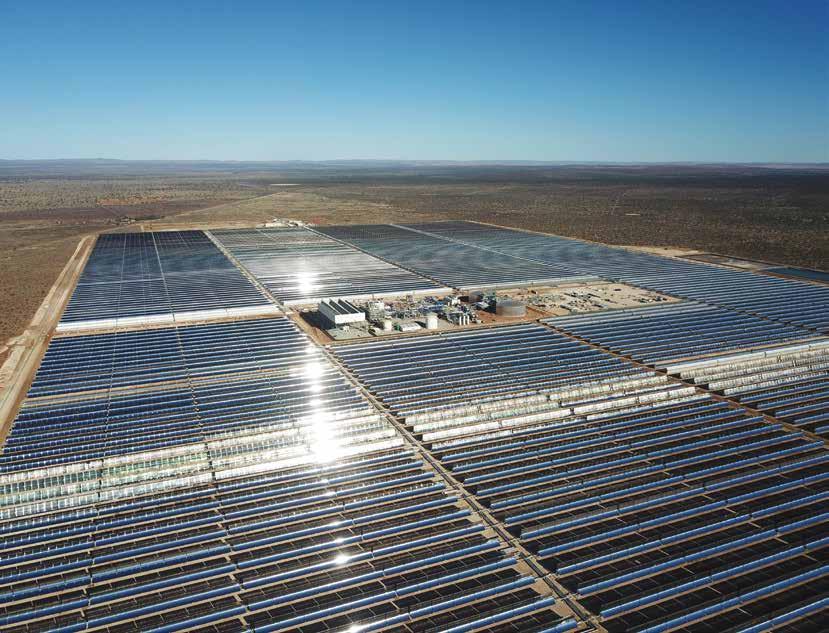
Water & Wastewater
Building the case for reuse
Environmental Engineering
Water control with mattresses
Cement & Concrete
Mastering cold weather factors

IMESA The official magazine of the Institute of Municipal Engineering of Southern Africa www. infrastructurenews.co.za infrastructure development • m aintenance • service delivery
SPRAS: The new approach to wastewater
Siyabulela Fanie ceo, opecs
AfriSam
Concrete contribution to solar energy
ISSN 0257 1978 Volume 44 No. 5 • May 2019 • R50.00 (incl. VAT)





















Use our rich media solution – video, animation and text – to reach and engage with your target market.
Media can be used in our: Digimags Newsletters Website
ADVERTISE Jenny Miller on +27 (0)11 467 6223 or jennymiller@lantic.net
SUBSCRIBE TO DIGIMAG +27 (0)11 233 2600 or subs@3smedia.co.za SIGN UP FOR NEWSLETTER www.infrastructurenews.co.za
Print and digital solutions for business communities www.3smedia.co.za Video ++= AnimationTextDynamicmessage
Rich
FOLLOW US infrastructurenews @infrastructure4
Grab your target market’s attention on
Complete water resource and wastewater management Water & Sanitation Africa ( + + (
T
www.infrastructurenews.co.za
OVER over 80 000 pageviews every month

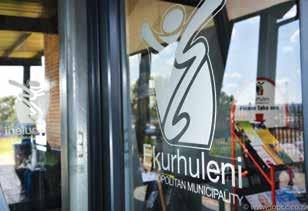
INdustry IN s I ght
The rapid rate of urbanisation, combined with steady population growth, is placing pressure on existing wastewater treatment plants. Siyabulela Fanie, CEO at OPECS, discusses a revolutionary and field-proven alternative. P10











As of 30 January 2019, a new source of solar power is boosting Eskom’s national grid from the Northern Cape town of Kathu, where a R12 billion generation plant has achieved commercial operation, following two years of construction that saw almost 65 000 m3 of concrete poured. P6



volume 44 no. 5 may 2019 IMESA www. infrastructurene ws INFRASTRUCTURE DEVELOPMENT MAINTENANCE SERVICE DELIVERY SPRAS: The new approach to wastewater Siyabulela Fanie INDUSTRY INSIGHT AfriSam Concrete contribution to solar energy Environmental Engineering Water control with mattresses Water & Wastewater Building the case for reuse Cement & Concrete Mastering cold weather factors Regulars Editor’s comment 3 President’s comment 5 Africa round-up 8 Index to advertisers 52 Cover Story Concrete contribution to solar energy 6 Industry Insight SPRAS: The new approach to wastewater 10 Municipal Focus | Ekurhuleni Leading the way 12 Water Utilities Building the case for reuse 14 A blueprint for rural water supply 16 Panel Discussion Nyeleti Consulting 19 UltraTech SA 21 Environment Planning for climate change 23
14 INSIDE Water Utilities Building the case for reuse Meters, Pumps & Valves A potential shift to AMR 25 Environmental Engineering Water control with mattresses 28 Geotechnical Engineering Flexible drainage 31 Information Technology Embracing the revolution: can you afford not to? 32 Three decades of IT innovation 35 Geomatics Cadastral surveying: What is it and why do we need it? 36 Dams & Water Storage Resealing Von Bach Dam 38 Cement & Concrete Mastering cold weather concreting 41 Crash-tested 42 Connecting countries and economies 45 The perfect seal 46 Transport, Logistics, Vehicles & Equipment Leading in the 20 t class 48 Ultimate multitaskers 50
38 45 31 Dams & Water storage Resealing Von Bach Dam geotechnical engineering Flexible drainage cement & concrete Mastering cold weather concreting
Consistent quality requires consistent excellence ...
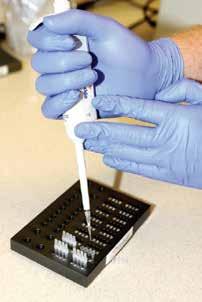


... in every area of wastewater management.
Serving both the public and private sectors, ERWAT promotes a healthy environment by providing cost-effective wastewater treatment solutions through innovative technologies. It specialises in sustainable, quality wastewater services, backed by focused technical, maintenance and engineering services. An ISO/IEC 17025 accredited laboratory renders a wide variety of specialised analyses, while industrial wastewater quality management assessments and advice are also offered.
East Rand Water Reg. No. 1992/005753/08
(Association incorporated in terms of section 21)
GPS Co-ordinates:
Address: Hartebeestfontein Office Park, R25, Bapsfontein/Bronkhorstspruit, Kempton Park.
Tel: +27 11 929 7000
E-mail: mail@erwat.co.za
www.erwat.co.za
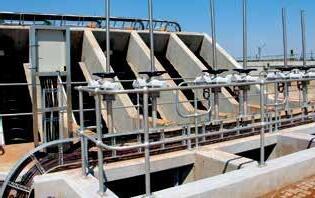

ERWAT EXCELLENCE
IN WASTEWATER
S 26° 01’ 25.8”
E 28° 17’ 10.0”
and
uppe marketing A13900
MANAGING EDITOR Alastair Currie
SENIOR JOURNALIST Danielle Petterson
HEAD OF DESIGN Beren Bauermeister
CHIEF SUB-EDITOR Tristan Snijders
CONTRIBUTORS Randeer Kasserchun, Bryan Perrie, Altus Strydom
OPERATIONS & PRODUCTION MANAGER
Antois-Leigh Botma
PRODUCTION COORDINATOR Jacqueline Modise
FINANCIAL MANAGER Andrew Lobban
DISTRIBUTION MANAGER Nomsa Masina
DISTRIBUTION COORDINATOR Asha Pursotham
SUBSCRIPTIONS subs@3smedia.co.za
PRINTERS Paarl Media KZN +27 (0)31 714 4700
ADvERTISING SALES
Jenny Miller Tel: +27 (0)11 467 6223
Email: jennymiller@lantic.net
Working with BRICS
On 27 April 1994, South Africa held its first truly democratic election, where everyone had the right to vote. The results of the May 2019 General Election will herald in the sixth democratically elected Parliament, which will be responsible for steering the country as one of the key economic leaders in Africa and the only nation on the continent to hold a place at the G20.
Corporation to drive its Renewable Energy Sector Development Project; and $480 million (R6.9 billion) to finance Eskom’s environmental protection project at Medupi.
PUBLISHER Jacques Breytenbach
Novus Print (Pty) Ltd t/a 3S Media
46 Milkyway Avenue, Frankenwald, 2090
PO Box 92026, Norwood 2117
Tel: +27 (0)11 233 2600 Fax: +27 (0)11 234 7274/5 www.3smedia.co.za
ANNUAL SUBSCRIPTION: R600.00 (INCL vAT) ISSN 0257 1978 IMIESA, Inst.MUNIC. ENG. S. AFR.
© Copyright 2019. All rights reserved.
IMESA CONTACTS
HEAD OFFICE:
Manager: Ingrid Botton
P.O. Box 2190, Westville, 3630
Tel: +27 (0)31 266 3263
Fax: +27 (0)31 266 5094
Email: admin@imesa.org.za
Website: www.imesa.org.za
BORDER
Secretary: Celeste vosloo
Tel: +27 (0)43 705 2433
Fax: +27 (0)43 743 5266
Email: celestev@buffalocity.gov.za
EASTERN CAPE
Secretary: Susan Canestra
Tel: +27 (0)41 585 4142 ext. 7
Fax: +27 (0)41 585 1066
Email: imesaec@imesa.org.za
KWAZULU-NATAL
Secretary: Ingrid Botton
Tel: +27 (0)31 266 3263
Fax:+27 (0)31 266 5094
Email: imesakzn@imesa.org.za
NORTHERN PROvINCES
Secretary: Rona Fourie
Tel: +27 (0)82 742 6364
Fax: +27 (0)86 634 5644
Email: np@imesa.org.za
SOUTHERN CAPE KAROO
Secretary: Henrietta Olivier
Tel: +27 (0)79 390 7536
Fax: +27 (0)86 629 7490
Email: imesasck@imesa.org.za
WESTERN CAPE
Secretary: Michelle Ackerman
Tel: +27 (0)21 444 7114
Email: imesawc@imesa.org.za
FREE STATE & NORTHERN CAPE
Secretary: Wilma van Der Walt
Tel: +27 (0)83 457 4362
Fax: +27 (0)86 628 0468
Email: imesafsnc@imesa.org.za
Collectively, the G20 country members, which include the BRICS group, alongside key players like Germany, Japan, the UK and USA, generate over 75% of global trade. They thus serve as an important economic hub when it comes to effecting positive change, particularly for developing regions. For this reason, adding additional African and Asian countries should be a priority to ensure meaningful representation. It’s also significant to note that within South America, only Argentina and Brazil are members.
On the African continent, a positive development in accelerating change is the appointment of South Africa’s president as the next chairperson of the African Union for 2020.
For South Africa, the BRICS relationship continues to open the door for greater intercountry investment and export opportunities, steered by the BRICS New Development Bank (NDB). At the fourth NDB annual meeting in Cape Town, held between 31 March and 2 April 2019, the stated plan was to “almost double its loan book to US$16 billion (R229 billion) this year and increase its impact, as the Bank seeks to broaden its global development partnerships and mobilise more institutional and private capital.”
Five new project loans amounting to around $1.2 billion (R17 billion) were approved at the end of March 2019, three of which are in South Africa. According to the NDB, these entail an approximately $220 million (R3.15 billion) loan to the TCTA to fund work on Phase II of the Lesotho Highlands Water Project; $80 million (R1.15 billion) to the Industrial Development
On 1 April, the NDB and the Development Bank of Southern Africa also concluded a new finance package. This entails a two-step loan, valued at up to $300 million (R4.3 billion), which will be channelled into funding local renewables ventures. These are likely to focus on biomass, wind and solar projects aimed at reducing the country’s carbon footprint.
Total NDB loans to South Africa now exceed $1.4 billion (R20 billion). The NDB says that there are plans to increase this to some $2.3 billion (R33 billion) by the end of 2019. That’s certainly exciting news for the local construction and allied industrial sectors.
Economic rebound
The South African economy is climbing back, following a particularly severe period of trading. According to Statistics SA, the formal business sector turned over some R2.57 trillion in Q4, up approximately 5.5% compared to Q3 2018. Manufacturing experienced the best improvement, recording a 7.1% gain between Q3 and Q4. Mining also experienced a 4.9% improvement, but construction is still in negative territory, recording a growth rate of -0.9%. The electricity, gas and water segment fell even lower at -17.1%.
Post elections, the expectation is that the construction sector will begin to see a surge in government funding inflows and an increased rate of tender awards.
Given our recent storm events across South Africa, there’s a substantial amount of maintenance and rebuilding required, which will dovetail with new infrastructure development.
Alastair

Cover opportunity







EDITOR’S COMMENT To our avid readers, check out what we are talking about on our website, Facebook page or follow us on Twitter and have your say.
In each issue, IMIESA offers advertisers the opportunity to get to the front of the line by placing a company, product or service on the front cover of the journal. Buying this position will afford the advertiser the cover story and maximum exposure. For more information on cover bookings, contact Jenny Miller on +27 (0)11 467 6223.
All material herein IMIESA is copyright protected and may not be reproduced either in whole or in part without the prior written permission of the publisher. The views of the authors do not necessarily reflect those of the Institute of Municipal Engineering of Southern Africa or the publishers. Infrastructure News @infrastructure4 IMESA official Institute Engineering Africa www.infrastructurene INFRASTRUCTURE DEVELOPMENT MAINTENANCE Thenew approach wastewater Siyabulela Fanie CEO, INDUSTRY INSIGHT AfriSam Concrete contribution to solar energy Environmental Engineering Water control with mattresses Water & Wastewater Building the case for reuse Cement & Concrete Mastering cold weather factors 1978 2019 R50.00 IMIESA May 2019 3
In memoria:
saying farewell to past presidents
Wesley Fourie , an esteemed member of iMesA and a Past President, passed away on 17 August 2018 in randburg. in his last position with the institute, he served as Honorary secretary – Treasurer.
Wesley was born in Hermanus in 1934. Following his matriculation from Paarl Gymnasium in 1951, he went on to study civil engineering at the stellenbosch university, graduating in 1956. He subsequently dedicated his working career to municipal engineering, starting as a junior engineer in Welkom, working in the roads and stormwater field. Wesley was then employed as senior engineer in Polokwane before moving to Vryburg in 1963 as town engineer.
During 1964, he was appointed as town engineer of ermelo. in 1970, he moved to randburg in the same capacity. on his retirement in 1994, he held the position of technical director for the city of randburg, and was responsible for all technical departments.
Wesley joined iMesA in 1964 and was appointed as a council member. He was elected as iMesA’s president in 1986. For 13 consecutive years, from 1982 through to 1994, he also served as iMesA’s secretary. His dedicated service to iMesA and municipal engineering was recognised by his election as an Honorary iMesA Fellow in 1988.







Tj AA r T VA n D er WA lT obtained a master’s degree and doctorate in Civil engineering Management at rAu (now uj). He delivered several papers on engineering management both nationally and internationally and was a recipient of the ‘Best Paper Award’ at the iMesA conference held in Durban in 2000.
He spent 20 years in private practice and 18 years in local government, and gained extensive experience in all facets of construction, municipal engineering and municipal administration. His first deployment in the municipal arena was as a civil engineering technician for roodepoort City Council in 1974.
During his 20 years in private practice, he was a partner, director and managing director of several companies, including construction, property and aircraft firms. He lectured part-time at uj for several years and moderated final-year engineering students. in his last public sector assignment, he was employed by the City of johannesburg in the Corporate Planning unit involved with research, strategic planning and performance management. He was a Past President and an Honorary Fellow of iMesA. Tjaart passed away on 4 April 2019.

IMESA Ob IT u ARIES
4 IMIESA May 2019

Flood control and countermeasures
As extreme weather becomes more severe, our municipal engineering interventions need to respond to cope with the erratic nature of climate change. There are some things outside our control, but it’s the way we anticipate and respond to them that counts.
During the recent spate of heavy rainfall across South Africa, many of our innercity roads were flooded as stormwater systems failed to cope with the deluge. In some cases, culverts and stormwater channels didn’t function optimally, either because they were blocked or simply overwhelmed in terms of their design capacity.
The broader KwaZulu-Natal region experienced particularly heavy rains and winds. Although Sanral reported that there was no structural damage on national provincial routes, some sections of the N2 and N3 were blocked due to landslides and flooding.
We also saw a spate of structural failures in buildings. A tragic example is the Pentecostal Church in Dlangubo, where a wall collapsed, killing a number of congregants. The cause has yet to be determined, but this reinforces the point that any structure, whether it’s a road, bridge or building, needs to be designed to withstand known, historic and projected storm conditions. Structures must be founded to specification and the correct drainage system installed to prevent undermining. In all instances, regular inspections must be part of the process.
Our informal settlements are especially exposed, particularly where homes have been built below flood lines or on hillsides.
Gabions as an intervention
In most cases, incorporating environmentally engineered solutions using gabions and river mattresses is a highly effective response to future flood events for rivers, channel
systems, roads and bridges, retaining slopes and embankments. This is especially the case where specific site locations experience extended dry periods and the ensuing erosion, an increasingly common scenario that exacerbates flood events.
Landslides and riverbank collapses can be prevented in the majority of instances if correctly engineered with gabions and/or mattresses, and at times combined with concrete retaining systems. A key factor is the control of drainage to prevent hydraulic pressure build-up. In this respect, gabions and mattresses are highly effective in slowing down water velocities while countering soil loss and erosion.
A further plus is that gabions are faster and cheaper to build than concrete structures. Environmental systems also predominately use labour-based construction techniques. For this reason, it’s an approved methodology in terms of the Expanded Public Works Programme and a great initiative to promote skills transfer and SMME development.
Gabions are, therefore, a perfect community initiative and will be a vital part of restoring infrastructure in the coming months, helping to stretch municipal budgets.
Water security
Managing water is a top-of-mind priority for municipal engineers, both in terms of disaster management and prevention, and storage. While most major dams across South Africa are now at 70% capacity or higher, there are still parts of the country experiencing drought conditions. For example, overall dam capacities for the Western Cape are at around 35.6%:
Cape Town’s overall storage was sitting at 47.3% towards the end of April.
Not surprisingly, most KwaZulu-Natal dam levels are on the rise. However, towns in northern Zululand, such as Nongoma and Ulundi, remain dry. A similar pattern exists in parts of the Eastern Cape and Free State. So it’s often a “feast or famine” approach. Our job as municipal engineers is to ensure sustainability of supply. Much of our stormwater is currently lost. This should be captured and reused, where practical. The balance can be safely channelled into our surrounding rivers and wetlands.


IMESA
P RESIDENT ’ S COMMENT IMIESA May 2019 5
Randeer Kasserchun, president, IMESA
Concrete contribution to solar energy

Based on concentrated solar power (CSP) technology, Kathu Solar Park is adding 100 MW to Eskom’s capacity – enough to supply 179 000 homes in the local community of John Taolo Gaetsewe District Municipality, Northern Cape, and South Africa as a whole, with clean and reliable energy. The project, developed by a consortium of local and international stakeholders, is part of the Renewable Energy Independent Power Producer Procurement Programme (REIPPPP) being implemented by the Department of Energy.
The CSP plant uses parabolic troughs, designed like curved mirrors, to direct and focus the sun’s energy on to an absorber pipe containing a heat-absorbing medium that carries the energy to the water in a


As of 30 January 2019, a new source of solar power is boosting Eskom’s national grid from the Northern Cape town of Kathu, where a R12 billion generation plant has achieved commercial operation, following two years of construction that saw almost 65 000 m3 of concrete poured.
boiler heat exchanger. Here, the heat is used to produce steam, which in turn drives turbines to generate electricity.
As one of the largest such plants in South Africa, it covers a footprint of 4.5 km², over which 384 000 mirrors have been installed. To make optimal use of the sun’s energy over the course of each day, a tracking system on each solar collector assembly makes sure that the sun’s rays are always focused on the absorber pipe. Using molten salt as a way of storing energy gives the system an extra 4.5 hours of thermal energy storage when the sun is not shining, so the plant can generate power for 16 to 18 hours a day.
EPC phases
The construction process began in May 2016, driven by a consortium formed by Acciona in partnership with Sener, which acted as the engineering, procurement and construction provider. Cement for the structures and foundations came from construction materials leader AfriSam, which supplied Kurumanbased contractor Agisane Civil Construction
with all readymix requirements. To meet the varying applications on the project, 19 different concrete mixes were used.
Much of the concrete was used for piling and the bases of the support structures for the thousands of parabolic reflectors, as well as for the foundations and supports for the large process elements in the project’s ‘power block’, at the centre of the solar field. These elements included bases for turbines, salt tanks, towers and storage vessels. For the reflector stands, about 40 000 reinforced piles were poured, with each stand foundation requiring four piles to a depth of 2 m to 8 m. Where soils were collapsible, making them unsuitable for piling, raft foundations were used.
The pit and towers for the storage area of the heat transfer fluid (HTF) system were another significant collection of concrete structures. Vessel tanks containing the HTF, which circulates through the solar fields to keep the salt molten, are held on concrete towers standing in a large concrete pit to contain any potential fluid spills. The HTF oil
C O v ER STOR y 6 IMIESA May 2019
Solar field with concrete bases
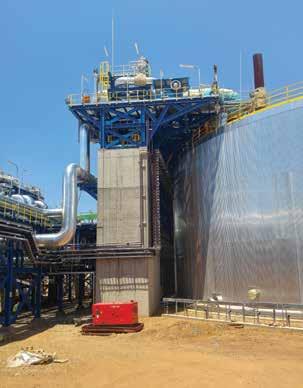
is heated to 400⁰C, so the columns holding the HTF storage vessels in the concrete pit were lined as a safety precaution. This lining included a special concrete mix using a lightweight expanded clay aggregate (LECA), which raises the concrete’s heat resistance to up to 1 000⁰C. This augmented a special treatment of the concrete floor of the pit, where three geolayers underlie the concrete pit base.
The large network of stormwater channels throughout the solar park, vital in providing adequate drainage and preventing erosion damage, also required considerable volumes of concrete. The area is generally dry, but rainfall can be intense and highly erosive.
Ambient temperature challenges
Among the most demanding pours for the large structures in the power block was for the turbine base, needing 2 000 m3

of concrete in five pours. In addition to the supply logistics to this fairly remote town, the high daytime temperatures created particular challenges for the concrete work. The turbine base pour, for instance, had to be conducted at night to make use of the coolest hours.
So hot were the ambient conditions that that the initial specification of a 30⁰C maximum limit for concrete had to be revised upwards to 35⁰C. The temperature of the fresh concrete was then measured continuously to ensure that it was within specification. Keeping within this limit meant applying several special precautions. For example, concrete was to be placed as quickly as possible, so trucks were not permitted to stand for more than half an hour before pouring; the temperature of each truck load was measured, both at the batch plant and the site of the pour.
The long pours, often at night, demanded a 24-hour cycle to be meticulously planned, so that schedules and resources could be closely managed. As the cement supplier, AfriSam sometimes had four or five bulk cement trucks from its Ulco plant near Kimberley waiting at the batch plant’s silos to replenish stock, as it was rapidly drawn out for the large pours. This was


to ensure that the silos could meet the overnight demand, and be topped up for the start of the day shift. Substantial stockpiles of aggregate would also be maintained at these times.
Other innovative techniques were adopted in the readymix process to deal with the intense heat. To adequately cool the concrete mix for the mass turbine base, ice was added to the 10 000 ℓ water tanks before the water was tapped into the mixer. Also, hessian was wrapped around the water tanks and kept wet, providing further cooling by evaporation.
Sustainable into the future
The environmental benefits of the project are mainly the saving of six million tonnes of CO2 emissions over its first 20 years of operation, but the social and economic benefits locally are also important. The site employed over 3 000 local workers and maintained nearly 42% of the staff from the local community. At its peak in September 2018, the project created 2 300 construction jobs. It is expected to continue promoting the local economy through various ventures such as a local community trust for the benefit of communities in John Taolo Gaetsewe District Municipality, as well as through the sourcing of services from local entrepreneurs.

www.afrisam.co.za
IMIESA May 2019 7
ABOVE Molten salt tank with concrete tower
ABOVE RIGHT Molten salt tank towers and pillars under construction
Concrete being pumped through the night in the turbine block
INFRASTRUCTURE NEWS FROM AROUND THE CONTINENT
sUb-saharan africa
funding renewable energy generation
The African Development Bank (AfDB) Group has agreed to invest up to $25 million in the ARCH Africa Renewable Power Fund (ARPF).
The $250 million private equity fund for renewable energy projects across subSaharan Africa is expected to reach first close in early 2019. The AfDB’s presence is expected to act as a catalyst for other investors to commit a further $60 million to $75 million equity from non-DFI sources.
ARPF will provide equity for the development and construction of 10 to 15 greenfield renewable energy projects in sub-Saharan Africa, adding approximately 533 MW of installed energy generation

capacity from renewable sources in the region.
ARPF projects will focus on mature technologies including wind, solar PV, small to medium hydro, geothermal and biomass. In addition to contribution to renewable energy, the project construction and operation will result in direct creation of at least 272 full-time jobs and 5 320 part-time jobs.
gambia linking nations
A newly opened bridge linking The Gambia to Senegal has improved goods transport and safety between the two nations.
The bridge is a safer and quicker alternative route to the risky ferry crossing or the long detour between the northern and southern parts of both nations.

The bridge, which spans the Gambia River, will enable free traffic flow between the northern and southern parts of both The Gambia and Senegal, and is expected to reduce travel time, boost trade and unite communities that were previously isolated. It will also facilitate and increase subregional trade and open up rural areas; while increasing the level and quality of service of the NouakchottDakar-Lagos road corridors
The 942 m long bridge, along with two border posts, completes the first phase of a
road project which has cost $93.68 million.
Kenya
major investment in housing Qatar is set to invest $3.5 billion in housing in Kenya. The funding is expected to aid in the development of 140 000 housing units in Kenya, as part of the government’s affordable housing strategy under the Big Four agenda.
Speaker of the National Assembly Justin Muturi lauded the investment, encouraging further partnerships to strengthen the bilateral relations between the two countries.
The Big Four agenda seeks to fast-track the construction of 500 000 low-cost houses, through the Kenya Mortgage Refinance Company. The National Assembly has also approved the establishment of the Kenya Housing Development Fund. Speaking on the subject, President
A new fund will finance greenfield renewable energy projects in sub-Saharan Africa
Uhuru Kenyatta noted that this is the first time that privatepublic partnerships will be instrumental in the provision of affordable homes.
mozambiqUe
enhancing water availability
With the help of the French government, Mozambique will undertake a project to harness ground water resources to enhance the availability of clean water in the Greater Maputo area.
The €6.2 million in French funding will allow for the establishment of 16 boreholes, a pumping station and pipes to carry water to the reservoirs. The aim is to make more than 40 000 m3 of water available to around 348 100 people in the southern Mozambican municipalities of Maputo, Matola and Boane by 2020.
The project will also include a programme to reduce water losses by the Maputo Regional Water Company.
The new 942 m long bridge between Gambia and Senegal will increase subregional trade
533 MW $3.5 billion
The ARPF will add 533 MW of renewable energy to subSaharan Africa
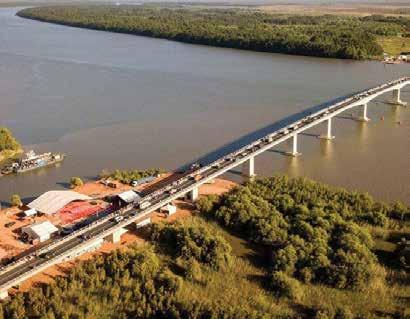
Qatar will invest US$3.5 billion for affordable housing in Kenya
Qatar will invest in the development of 140 000 affordable housing units in Kenya
8 IMIESA May 2019

SPRAS: The new approach to wastewater
The rapid rate of urbanisation, combined with steady population growth, is placing pressure on existing wastewater treatment plants, pushing up processing and maintenance costs, as older facilities struggle to keep pace with rising inflows. imiesa speaks to Siyabulela Fanie, CEO at OPECS, about a revolutionary and field-proven alternative.
Operations and Enhancements Consulting Services (OPECS) entered the wastewater segment in 2015, following the conclusion of a partnership agreement with Chinese OEM Jinluo Water – a leader in water and wastewater solutions. Jinluo is ranked in the top 50 privately registered companies in China, a remarkable achievement given this highly competitive domestic market.
Within the wastewater sector, Jinluo’s proprietary SPRAS (Sludge Process Reduction Activated Sludge) technology challenges conventional treatment approaches. There are three key factors to note:
• No chemicals are required for the processing of domestic wastewater, while only a nominal portion is needed for industrial effluent.
• No downstream organic sludge is generated – it’s broken down and eliminated – so that rules out the issue of sludge discharge, which remains problematic and costly for conventional plants in terms of disposal and environmental compliance. Plus, the elimination of chemical dosing passes on major operational cost savings for utilities and municipalities.
• SPRAS is energy efficient, consuming as little as 0.5 kW per m3. Plants can run on a combination of mains, generator and solar power. But even without any power, the SPRAS treatment stream continues uninterrupted for up to eight hours, thanks to the inherent technology.

Our goal is to partner with national government, municipalities and consulting engineers to collaborate in accelerating water and sanitation delivery.”


Industry Ins I ght

It’s a unique anaerobic-anoxic-aerobic process, with the end stage entailing UV radiation to ensure the final disinfection of the treated water. During the processing stage, raw wastewater enters a holding or buffer tank, which regulates the flow at a constant rate before feeding through to the SPRAS treatment tank.
Plug and play
“The overriding benefit is that the wastewater treated in our package plants meets Department of Water and Sanitation and international quality standards, plus it’s a plug and play solution, which means it’s a site-specific response that’s not reliant on centralised conventional infrastructure layouts that include sewer lines running for kilometres,” Fanie explains.
The technology is also ideally suited to meet various reuse applications: some 90% of the treated water is reusable. That’s an important point to emphasise since South Africa is a water-scarce country that, along with many other nations worldwide, faces challenges when it comes to delivering clean potable water.
“Going forward, we have to rule out using potable water for non-human consumption

Benefits of sPRAs technology
needs and SPRAS fills this gap. Reuse must become the norm for non-potable requirements like crop irrigation, toilet flushing, construction, and general cleaning. In this respect, SPRAS is an ideal solution,” he continues. “It’s the answer when it comes to supplementing or supporting conventional wastewater treatment plants nationally, a number of which are not compliant and are discharging raw, untreated effluent into rivers.”
Pilot projects and commercialisation Since entering the market, OPECS has successfully completed two pilot projects that have proven the efficacy of the technology, then subsequently moving on to full-scale commercial operations. Plants can be supplied in a broad range of sizes, from as small as 70 m3 per day to 10 Mℓ facilities and higher. The technology also lends itself to BOOT (build, own, operate and transfer) opportunities.
The first pilot study was completed for the Sundays River Municipality in the Eastern Cape, where an existing treatment plant was not performing to standard. OPECS deployed two 150 m3/day package plants to increase the capacity of the existing facility. This had a direct benefit for the region’s citrus growing community, which was now able to comply with export standards thanks to the use of compliant irrigation water supplied via the OPECS plants.
The second pilot study was for Chris Hani Municipality in Cradock, Eastern Cape, where OPECS deployed a 300 m3/day plant, also as a backup to the in-situ treatment works. This was an urgent intervention, as the municipal plant was discharging raw sewage into the river.
Glen Agricultural College

second year. This plant, which is owned by the college, replaced an obsolete, existing plant.
Before the college went out on public tender, it analysed the costs of refurbishing the existing plant. OPECS’s package solution came in at around half that price. The savings are even greater when the cost of chemicals is subtracted from the college’s future operational expenditure budget.
OPECS has three units running at the college. Combined, they treat approximately 450 m3 daily, serving some 2 800 people. Like with all package plant installations, they are designed to work together or independently, so they can be scaled up or down depending on the load.
In terms of new projects, OPECS recently concluded a three-year agreement with the Free State Department of Basic Education to roll out package plants at designated schools across the province. This will be on an O&M basis.
Growth in Africa
OPECS is also responding to recent enquiries from a number of African countries, which include Kenya, Nigeria and Rwanda, all of which have identified sanitation as a national priority. In the meantime, OPECS has secured a contract for a private residential developer in Kenya.
“Our goal is to partner with national government, municipalities and consulting engineers to collaborate in accelerating water and sanitation delivery,” says Fanie. “We believe SPRAS would be ideal for many new community developments that can now be developed with decentralised treatment facilities. SPRAS technology is compact and efficient, and odourless, plus its operation is silent, making it well suited to urban environments. Additionally, our plants can be installed alongside conventional works to supplement and increase capacity.
“In the meantime, we are expanding the business to meet current and future growth demands, focusing on recruiting and developing the best engineering and technical talent. That will be combined with ongoing organic growth through project excellence,” Fanie concludes.

OPECS’s first commercial project was for the Glen Agricultural College, an institution falling under the Free State Department of Agricultural and Rural Development. This OPECS operations and maintenance (O&M) project is now in its www.opecs.co.za
IMIESA May 2019 11
Industry Ins I ght - no organic sludge discharged during wastewater treatment - Water reuse - reduced footprint compared to conventional wastewater treatment plants - lower electricity consumption - Flexible construction (semiunderground or above ground) - no chemicals used to treat wastewater
easy maintenance, with built-in remote monitoring system
-

Leading the way
In his recent State of the City Address, Ekurhuleni Executive Mayor Mzwandile Masina made a bold claim: “Ekurhuleni is outperforming the other metros in the areas of delivering water services, sanitation services and renewable energy.”

When Ekurhuleni’s current dispensation took office in 2016, a programme of action was outlined to advance a pro-poor agenda focused on the roll-out of service delivery and economic development opportunities in a manner that uplifts the poorest sections of the city.
Under this action plan, a number of promises were made, to be delivered over the fiveyear term of office. These included:
• Electrifying all informal settlements
• Constructing 100 000 housing units
• Providing 59 000 service stands
• Making informal settlements more habitable by upscaling services
• Promoting preservation of water and continued investment in water infrastructure to ensure security of supply
• Building an Ekurhuleni Power Station
In his address, Masina stated that the city had come a long way in building a local economy that grows in the hands of the people.
“True to the success of our revenue collection and financial management systems, we have registered profound progress in the period under review. Our capital budget increased by an average of 10.5% per annum, from R2.3 billion to R6.5 billion. For the last financial year, the city funded its own capex – a testament to our financial health and credibility,” he said.
Electrifying informal settlements
Over the past 24 months, Ekurhuleni rolled out an informal settlement electrification programme leading to the installation of 33 236 PV lights. According to Masina, the city electrified 8 981 households, bringing the total number of connected households in informal settlements to 15 590. An additional 6 926 informal households are expected to be electrified by the end of June this year.
Investing in water and sanitation
Ekurhuleni has embarked on a programme to build 29 reservoirs from 2018/2019 to 2021 with a combined storage capacity of 550 Mℓ. To date, three reservoirs with a combined capacity of 55 Mℓ have been constructed, and work on a further nine reservoirs will commence before June 2019 to add a further 140 Mℓ of storage capacity. As a result of unmatched growth demand, the existing reserve capacities in some areas of the city can only supply between 2 to 10 hours in the event of water interruption. The construction of new reservoirs will ensure security of water supply and inter-link the water supply from one zone to another.
Mun I c I pal Ins I ght | Eku R hul ENI 12 IMIESA May 2019
Executive Mayor Mzwandile Masina, Ekurhuleni Metro

The municipality has also added 11 323 new connections for water and sewer to formal dwellings, along with the installation of 23 483 new water meters. This investment helped to reduce water losses from 34.3% to 30.85% over the past 12 months. Another 12 537 water service points were installed in informal settlements to improve access points and reduce distance travelled to collect water.
As part of the integration of informal settlements, the household ratio of chemical
toilets has been reduced from 1:10 to 1:5. These chemical toilets are regularly serviced, and Masina says the city is looking at ways to improve the efficiency of this service at a contained cost. The city will also be investing in an alternative sanitation programme.
Building houses
Masina reports that the city has completed 26 000 low-cost houses over the past 24 months and is in the process of constructing three housing mega projects, namely John Dube, Daggafontein and Leeuwpoort, with a combined total yield of 50 571 units.
Ekurhuleni’s approach to human settlements is to deliver a combination of subsidised, low-cost and rental stock to advance the life chances of the city’s residents. “We provide them with free housing when their economic means are dire; we offer them rental stock when they have slightly improved and will also
26 Nagington Road, Wadeville, Germiston 1400, South Africa
Tel +27 11 824 4810 / Fax +27 11 824 2770
E-mail info@apepumps.co.za / info@matherandplatt.com Website www.apepumps.co.za / www.matherandplatt.com

Split Case Pump
• Sugar and Paper
Refineries


encourage them to graduate into bonded houses in an area of their choice when their economic fortunes have increased,” said Masina.
The city has also been embarking on the regularisation of townships since 2016 to assist with the conversion of leasehold erven to freehold erven, providing residents with title deeds.
Leading the metros
“Overall, we are doing better than almost all municipalities in Gauteng. More instructive is the fact that we are a leader of our peer group of metros. We have performed better than all the other metros in terms of the level of citizen satisfaction in the Quality of Life assessment,” said Masina.
“In light of the fact that we are the youngest city and have a much more pronounced spatial legacy of apartheid, we should all be proud that we are now ranked as the city affording its citizens with the highest quality of life in comparison to other metros in the province.”





Mun I c I pal Ins I ght | Eku R hul ENI
Chemical Horizontal Multistage Pump Power Generation Plants Cooling and Heating Systems Mining Applications Vertical Turbine Cooling Water Circulation Irrigation Locally Manufactured
Mills •
• Petro
Building the case for reuse

As a water-scarce country, South Africa needs to diversify its water mix, moving away from a complete dependence on surface water resources. But are we doing enough? b y Danielle Petterson
Globally, two-thirds of the population live in areas experiencing water scarcity, and water demand is beginning to exceed supply in many regions.
In South Africa, 98% of available water resources have been allocated, with 77% of this comprising surface water.
In the face of growing and competing demands, water reclamation and reuse is gaining momentum as a reliable way of augmenting supply. However, Jeremiah Mutamba, manager: Water-Centred Knowledge, Trans-Caledon Tunnel Authority, questions whether South Africa is doing enough to manage the potential water deficit it faces.
He points out that although South Africa has plans and strategies in place that
feature reuse, little has been done to move from studying and planning to implementation.
Global successes
Water reuse has been practised for around 5 000 years. Today, the water reuse trend has been increasingly supported by improving technology, treatment costs and a growing supply/demand gap, with countries such as France, Israel, Portugal, Singapore and the USA leading the way.
Mutamba points to China as a prime example of how reuse can be embraced during tough times. The country, which is increasingly facing freshwater supply challenges, is among the 13 countries with the lowest water availability per capita. As a result, China has made water reuse a key component of its national water strategy.
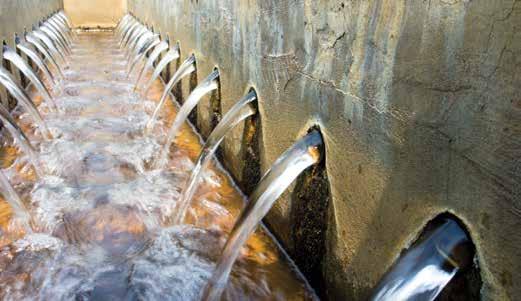
In 2016, China reported that 21% of its 2 billion m3/year of treated wastewater was being reused. Similarly, Australia reuses 21% of its treated wastewater. Closer to home, Namibia has been a pioneer, driving reuse since the 1960s.
However, Mutamba notes that countries like Australia have clear targets that push them to move from planning to implementation. South Africa, on the other hand, does not have a dedicated institution driving reuse.
“We do not have national commitment to incorporate reclaimed water into the water mix. Other countries drive this with rigour and set targets,” he says. Beyond the national reuse strategy and reconciliation recommendations, there is no tangible, nationally driven reuse agenda.

Water u t I l I t I es

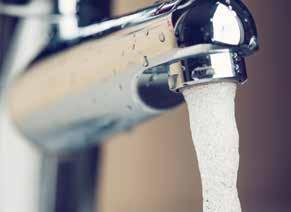
Johan Lubbe, product development specialist, Development Bank of Southern Africa, explains that although there are some notable examples of reuse in South Africa, we have not yet seen the adoption of largescale projects and programmes.
“The reuse agenda in South Africa is very ad hoc and fragmented. There is a need for integration, boldness and bravery. It is not a sprint – it is a marathon,” adds Mutamba.
The perception challenge
Mutamba argues that reused wastewater has the potential to meet 15% of our national demand; however, there are some critical challenges that must be overcome if it is to be fully embraced.
The biggest challenge is public perception. Despite the advancements in technology, there is still resistance when it comes to water reuse for drinking purposes.
Public perception, social, cultural and religious beliefs often prevent direct potable reuse options from being considered, despite the fact that the technology exists to treat wastewater to the required potable standard. “We need a national education programme
or campaign to start changing people’s mindsets around reuse. Without this, no project will be successful,” says Lubbe. Similarly, Mutamba stresses that despite scientific excellence and technological advancements, a reuse project can fail if people do not trust the product. “It is essential that the public and other stakeholders accept the product.”
Mutamba believes the future success and trajectory of reuse in South Africa very much depend on navigating what he calls the trust dividend. This requires political buy-in, acceptance from all stakeholders, knowledge, and improved stewardship.
There is also a negative perception around the perceived complexity and costliness of reuse, although it offers a cheaper alternative to desalination. However, Lubbe stresses the need for cost-effective tariffs, arguing that South Africa’s low tariffs for what is fast becoming a scarce resource often result in people not valuing water.
Reuse infrastructure as an asset class
In addition to adopting a programmatic approach to reuse in South Africa, funding options are needed to make the application more viable.
Lubbe called to the establishment of a national reuse programme that will support the preparation, financing, and implementation of municipal water-reuse projects. This kind of programmatic approach offers many benefits, including the establishment of best practices and technologies, cost optimisation, and the standardisation of contracting documents and procurement.
The aim is to create a new asset class by using credit enhancement to crowd in private sector funding and use debt capital market instruments to focus and define the asset class.
The idea is to have an asset class of largerscale water reuse infrastructure assets that offers acceptable financial returns but is in line with ESG impacts and helps to meet the Sustainable Development Goals.
Lubbe argues the project bonds are likely the best instrument to achieve this, because they are designed to fund largescale infrastructure projects. Furthermore, the regulatory environment and listing requirements for project binds are already in place on the JSE.
The biggest problem at the moment is bankable projects. Encouragingly, some municipalities have begun to explore reuse infrastructure at scale, but the bankable feasibility studies must still be undertaken, and financing methods established.
Lubbe goes on to propose three possible funding solutions:
1. Convention (municipal balance sheet)
2. PPP/concession (design, build finance, O&M)
3. Hybrid (PPP without finance)
These, he says, offer the ability to respond to and finance projects at scale.
“The time has come for us to extract maximum value from our water resources by using water more than once. For most of us, load-shedding is probably an inconvenience, but water-shedding will be a different story. We have no option but to look to water reuse as one of our water supply options, and this has to be done quickly and at scale.”
IMIESA May 2019 15
A blueprint for rural water supply
A unique community-based water supply scheme developed by JG Afrika has made a lasting difference for a remote rural community in north-west Botswana.
The Botswana Ministry of Land Management, Water and Sanitation Services hosted an event on 20 March 2019 to celebrate the formal handover of the Habu Community Water Supply infrastructure. The scheme has been successfully managed by the community for two years.
Bogadi Mathangwane, director of Botswana’s Department of Water Affairs, said the stellar performance of the scheme since its completion in 2016 has provided ample evidence that they now have a potential blueprint for similar communitymanaged initiatives nationwide.
Held at a kgotla in Habu village, the event was also attended by Dr Obolokile Obakeng, Deputy Permanent Secretary of the Ministry of Land Management, Water and Sanitation Services; and representatives of the Water Utilities Corporation (WUC).
Ruth Stewart, managing director of Initiatives; Robyn Tompkins, an executive associate at JG Afrika Botswana; and Attie Jonker, managing director of Franklin Electric, as well as executive director of the Franklin Wells for the World Foundation, were also in attendance.

Tompkins, a water, sanitation and health (WASH) development expert, led the JG Afrika team appointed by Initiatives to assist in the design and development of this first-of-its-kind water supply project. This was commissioned on behalf of the Paul G Allen Family Foundation’s Philanthropy programme.
Franklin Electric was contracted by JG Afrika to install the borehole pumps. Franklin Wells for the World Foundation also donated borehole infrastructure, alongside that supplied by the Paul G Allen Family Foundation. This allowed the project team to install two boreholes. Together, they are more than sufficient to supply the needs of this large community of around 1 500. Prior to the completion of the scheme, members of the Habu community were without a reliable water supply for up to three years.

Before JG Afrika completed the water scheme, members of the Habu community did not have a reliable supply of water for up to three years
“When Robyn initially presented this concept to me in 2015, I wondered if it could be done, because we had tried this model in other communities and it hadn’t worked,” says Mathangwane. “However, she presented a clear roadmap of how they could work; today, I see it has.”
Overall, the major success factor was the attention given to the social aspects from the onset, which ensured the necessary community buy-in.
Essential toolkit
JG Afrika developed a robust governance framework for the scheme and a toolkit to train representatives of the dedicated wateruser committee, comprising two caretakers and five water monitors. These community members also underwent technical training in basic infrastructure maintenance to cover most repair or servicing scenarios.
Community members pay for their consumption by registering with a water association. They present a stamped token to the monitors, who open the taps at 09:00 and lock them at 18:00.
The set-up consists of five tanks on stands that supply taps located at a central point for each of Habu’s five wards. Pumps are powered by solar energy and governed by manual switches. A manual system ensures that community caretakers are in constant contact with the system.
The Integrated Water Resources Management & Water Efficiency Plan was developed by the Botswana Government in 2013. “The country’s authorities are in the
Water u t I l I t I es 16 IMIESA May 2019
Attie Jonker, MD of Franklin Electric (left), presents Dr Obolokile Obakeng of the Botswanan Ministry of Land Management, Water and Sanitation Services, with a copy of the SAICE Outstanding Engineering in a Community-Based Project award

process of developing a water-catchment model in which water-user associations and committees are an important subcomponent of the management of the country’s water resources,” says Tompkins.
In 2017, the World Bank approved a US$145.5 million loan to improve water
availability in Botswana’s drought-prone areas. This includes the augmentation or rehabilitation of existing water schemes, which is expected to benefit over 450 000 people.
Tompkins is now planning to host a workshop for representatives of the
JG Afrika developed a robust governance framework for the scheme and a toolkit to train representatives of the dedicated water-user committee, comprising two caretakers and five water monitors
WUC and the Department of Water and Sanitation, the latter now being the owner of the Habu scheme, to fine-tune the service delivery model. She sees immense potential to incorporate information and communications technologies used successfully in other African countries and elsewhere in the world to bolster monitoring and evaluation of these watersupply projects.
In recognition of the collective achievements at Habu, JG Afrika received the award for Outstanding Engineering in a Community-Based Project at the South African Institution of Civil Engineering annual awards in 2018.



Proudly independent, proudly South African and proud to service Africa, JG Afrika has built a strong reputation for offering innovative and sustainable engineering and environmental consulting services of the highest quality. A Proud Past. A Bright Future. Great reputations are built over time. www.jgafrika.com Level 1 B-BBEE Water u t I l I t I es
The official opening of the scheme, which consists of five tanks on stands that supply taps located at a central point for each of Habu’s five wards
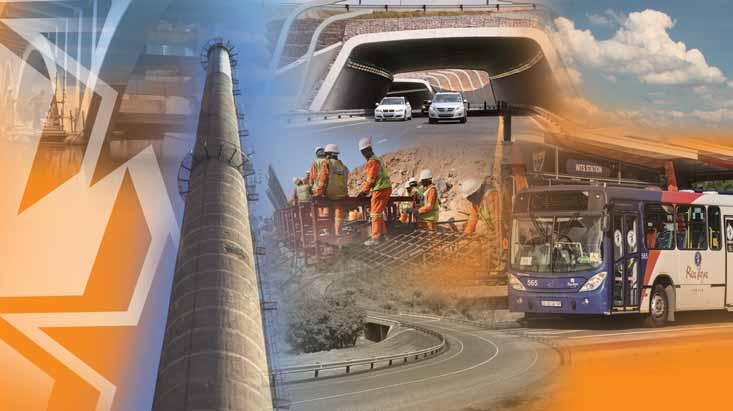





NYELETI CONSULTING
What are some of the biggest challenges you see at water and wastewater utilities?
at & ss We often see technical capacity challenges and budgetary constraints that prevent utilities from offering world-class services.
Unfortunately, a lack of investment in infrastructure, particularly due to the absence of planning and preparation of bankable projects, is often coupled with a reluctance to embrace private sector funding and support through risk-sharing mechanisms like privatepublic partnerships or even privatisation. What we are left with is ageing infrastructure that is often not sufficiently maintained, and therefore susceptible to regular breakdowns. In the case of wastewater infrastructure, this results in the overflow of sewage into natural watercourses, causing damages to the environment and living species, and posing health risks to human beings and livestock. In the case of water infrastructure, millions of litres of scarce water resources are wasted.
How can Nyeleti assist utilities with the operations and maintenance of their water infrastructure?
Sustainable operations and maintenance of any infrastructure is dependent on several factors, key ones being capacity development and training of operations and maintenance staff. The others are materials, machines, methods and funding. Capacity development and skills training is therefore critical for the successful
operations and maintenance of water infrastructure, with capable management ensuring that maintenance is budgeted for, appropriate maintenance tools are used, materials and parts are in stock and correct operations and maintenance methods are followed.
At Nyeleti, we have the skills and experience to support municipal and water utilities with operations and maintenance of infrastructure, which includes capacity development, diagnostic review of existing operations and maintenance activities (including composition of teams, training needs, etc.), re-engineering of operations and maintenance teams and processes.
What about new infrastructure projects?
Nyeleti has the skills to support municipal and water utilities with planning, preparation of bankable projects, design, operation and maintenance of infrastructure. We are involved with our clients’ operations and maintenance personnel during all stages of project development to ensure that they understand the design rationale so as to better operate and maintain the infrastructure.
What are some of the most important things to keep in mind when
designing modern water and wastewater infrastructure?
It is important that South Africa stays abreast of the latest international trends, technology and design techniques. However, an appreciation of the existing skills and knowledge of plant operators is important when developing infrastructure to ensure that the appropriate technology is implemented. When used correctly, technology can reduce risks and provide high levels of assurance as well as a method to record large quantities of quality data. However, one must always consider the operating environment, budgets and, therefore, appropriateness of such technologies.
Involving the client’s operations and maintenance personnel in all stages of the project development, and training them on correct operation and maintenance methods, is particularly helpful when implementing new technology. Design software has evolved, allowing for improved visualisation and project development timeframes, which can greatly assist in this process.
 Director
Director

How is Nyeleti embracing modern technology and Industry 4.0?
Modern technology brings with it the ability to optimise infrastructure, thereby reducing costs both in terms of design and construction.
Nyeleti has invested in modern design software, such as 3D designs and BIM, and our software capabilities allow us to use tools such as virtual reality to provide clients with improved perspective of the project. By applying appropriate technology on projects, we are helping our clients to ensure long-term sustainability by improving infrastructure and operations. We know that technology is the future and we are focused on developing young talent in order to maximise the use of current and future technology, thereby enhancing the power of human creativity.

PANE l D ISC u SSION | Water u t I l I t I es
Abe Thela | Director
IMIESA May 2019 19
Stuart Seath | Technical
WITH 3 GROUNDBREAKING PRODUCTS
Wastewater and sewage are pumped underground to the lifting station where it is chemically treated and sent for separation. By dosing our Ultra S3® (RSS) at the lifting station, it eliminates H2S within 3 minutes of contact time - completely removing the smell and associated occupational hazards associated with H2S. By eliminating H2S with Ultra S3® (RSS) at this point it also removes sulphuric acid - one of the major contributor to infrastructure corrosion.
Our broad spectrum Ultra-Archaea® microbes are dosed into these primary settling basins targeting organic waste and hydrocarbons present in wastewater. Ultra-Archaea® metabolises Ammonia, Nitrate, Nitrite, Phosphate, E-Coli, Faecal Coliforms, Petroleum contaminants (incl. PAHs2) and odours in a very short space of time, reducing the chemical oxygen demand (COD and BOD). By replacing or running the Ekosource Magnetic Ballast Clarifier (MBC) in parallel with the primary settling basin, the MBC can increase the treatment capacity by 2 to 3 times. It reduces the solids loading on the clarifier, increases the settling ability of the clarifier, and increasing the biological treatment capacity of the system.
Effluent is then pumped to the aeration tank where Ultra-Archaea® is introduced in order to accelerate and oxygenate active sludge systems to further breakdown harmful bacteria.


By replacing chlorine with Ultra S3® (RSS) solution in the disinfection station, it will destroy common non-pathogenic bacterium and also pharmaceutical contaminants thereby eliminating the reliance on expensive, dangerous and corrosive chlorine gas.


Secondary clarifiers gravity feed the water through and continues to clean the water to a potable level. An Ekosource MBC can be installed after or in parallel with the secondary clarifier to remove phosphates that are precipitated by the addition of an aluminium or iron salt.

WWW.ULTRATECHAFRICA.COM SOUTH AFRICAN BASED +27 81 264 5104 | info@ultratechafrica.com Let’s change the way we think about the performance of water treatment in Africa! ADVANCED WASTEWATER TECHNOLOGY
WASTEWATER
TREATED

U LTRAT EC h SA
Shaun Blackmore-Reed | Director
What are some of the biggest challenges in the wastewater treatment space?
sb The Department of Water and Sanitation reports that around 56% of wastewater treatment works (WWTWs) are in poor or critical condition – the Vaal crisis is a prime example of this dire situation. Unfortunately, these problems would cost trillions to fix, using traditional methods.
Maintenance is often not prioritised, and the harsh nature of WWTWs means they are frequently exposed to high levels of hydrogen sulfide (H2S), which causes significant corrosion damage and is also the leading cause of gas inhalation deaths in the industry.
How do you combat the threat of H2S?
By eliminating H2S, you not only drastically reduce corrosion and odours – which translates into savings on maintenance, repairs and downtime – but you also create a safer work environment. While H2S simply results in an unpleasant rotten egg smell in lower quantities, in higher amounts it signals your diaphragm to shut down, posing a serious safety concern.
Our Ultra-S3® product is an effective oxidising system suitable for WWTWs and a number of other related applications like abattoirs. Up to 3.5 times faster and 241% more effective than hydrogen peroxide (H2O2) alone, Ultra-S3 eliminates H2S quickly and efficiently. However, the two can be combined to form our Rapid Sanitizing System (RSS), which is
three times more powerful than chlorine, making it ideal for WWTWs.
The RSS gets injected into the water stream to produce a compound that separates H2S into water and elemental sulfur so quickly that they cannot recombine, effectively eliminating H2S within three minutes.
What makes RSS so ideal for South Africa is that it can be introduced without making any changes to existing infrastructure, and the entire process is monitored by sensors, eliminating opportunities for error. Furthermore, utilities can save up to 50% on their monthly chemical bill by eliminating chlorine and other associated chemicals.
What are the other applications for Ultra-S3?
Ultra-S3 is also a powerful sanitiser and has been shown to eliminate many common bacteria, including Pseudomonas aeruginosa and Corynebacterium aquaticum, both of which present serious health threats. Ultra-S3 and RSS have also been shown to remove emerging pollutants like pharmaceuticals, which our current WWTWs are simply not designed to treat.
For a more holistic sanitising solution, S3 can be combined with our Ultra-Archaea® product.
Tell us more about Ultra-Archaea.
Ultra-Archaea was first developed to eliminate the toxic conditions associated with oil spills, and proved its effectiveness in

cleaning up the Deepwater Horizon spill in the Gulf of Mexico in 2008. However, the product also offers an excellent solution for wastewater treatment due to its affinity for organic waste matter.
Ultra-Archaea is a range of natural microorganisms that speed up the rate of natural degradation and help the bioremediation process occur in days and weeks rather than months or years. The microorganisms have a lifespan of around 12 weeks and will remain active as long as there is a food source, digesting hydrocarbon molecules and breaking them down into harmless by-products of water, carbon dioxide and lipids.
Ultra-Archaea is a completely natural solution and has been shown to be highly effective. In a controlled study with samples from the Deepwater Horizon spill, Ultra-Archaea was found to perform better than three other leading products. Most notably, it removed 98.5% of PAHs (polycyclic aromatic hydrocarbons).
Are these products safe for the environment?
Absolutely. Ultra-S3 has passed all three of the CSIR’s toxicity tests with a Class I result and has been classified as nonhazardous under the USA’s Toxic Substance Control Act of 1976. It is chemically engineered to target problem compounds without destroying environmentally beneficial microbes, and actually supports good biology by oxygenating water. There is also no threat to overdosing. In fact, the opportunity exists to purposefully overdose with S3 and Ultra-Archaea to help remediate catchment areas where sewage spills have occurred.
Ultra-Archaea is also completely safe because the microbes are 100% natural and not genetically engineered or modified. They are non-toxic and non-pathogenic.
Together, the products offer simple, fast and cost-effective solutions that have been successfully used in the US for decades.

IMIESA May 2019 21
PANE l D ISC u SSION | Water u t I l I t I es



















t +27 (031)266 3263 e conference@imesa.org.za conference.imesa.org.za Book online now REGISTRATION Register and pay BEFORE 28 June 2019
Members: R6 100 • Non-members: R7 300 IMESA ORGANISER THE INSTITUTE OF MUNICIPAL ENGINEERING OF SOUTHERN AFRICA (IMESA) TEL: 031 266 3263 DEBBIE OR MELANIE Earn 2.5 CPD opened has DURBAN INTERNATIONAL CONVENTION CENTRE 83RD IMESA CONFERENCE 02-04 October 2019 STANDARD REGISTRATION Register and pay AFTER 28 June 2019 • Member: R6 900 • Non Member: R8 100 CONFERENCE ENDORSED BY GOLF COMPANION TOUR R520, excl. Golf cart and caddy R1 100 per person
•




Planning for climate change
The CSIR’s Green Book is a novel and unique attempt at interdisciplinary, applied sciences that combines the expertise of researchers across a broad spectrum. These include climatology, demography, disaster risk sciences, environmental sciences, geography, informatics, urban planning, economics, ecology, architecture, anthropology, hydrology and statistics.
The Green Book forecasts to the year 2050 by projecting human settlement growth combined with quantitative, scientific evidence of the likely impacts that climate change will have on towns and cities. Every settlement risk profile proposes customisable adaptation actions, to be considered for integration into local plans and strategies.
There are three main components. The first is a series of interactive national story maps. The user is able to browse through them to learn more about the research methodology, findings and recommendations, as well as to access the technical reports and interactive datasets.
The second component is the municipal Risk Profile Tool. This provides dynamic risk profiles for each municipality and its associated human settlements in South Africa. They provide information on vulnerabilities, population projections, exposure to climate hazards, and the impacts of climate change on key municipal resources.
The third component is the municipal Adaptation Actions Tool, which offers a range
The Green Book, its resources and tools can be accessed online at www.greenbook.co.za

of planning and design actions for municipalities.
The Green Book also provides information on adaptation planning at a local government level. This includes information on why it is important to plan for climate change, how to deal with uncertainty, and the mechanisms that support climate change adaptation. The latter include disaster risk reduction, funding mechanisms, capacity building and awareness raising, and as well as monitoring and evaluation.
Known as the Green Book, the CSIR has launched a state-ofthe-art online climate risk profiling and adaptation tool to assist municipalities with their spatial planning.
The development of the Green Book was funded by the International Development Research Centre in Canada and the CSIR, and partnered by the National Disaster Management Centre. The Department of Environmental Affairs, the National Disaster Management Centre and Santam are committed to partnering with the CSIR on Phase II of the Green Book.
”This phase will focus on rolling out the Green Book for implementation in municipalities

most at risk, identifying gaps in research and development of this kind, and building the capacity of officials and departments to deal with climate change adaptation,” comments Willemien van Niekerk, senior researcher and project lead, CSIR.
“Given the risks, there is a great need for proactive investment in disaster risk reduction in South African urban settlements in order to cope with increasing extreme events in future,” Van Niekerk concludes.



IMIESA May 2019 23 E N v IRONMENT

HOW DOES UNRELIABLE WATER SUPPLY IMPACT
INCREASE RELIABILITY WITH GRUNDFOS SOLAR SQFLEX PUMPS


POWER FROM ANY SOURCE
A built-in frequency converter ensures that the motor runs on both AC and DC from power sources such as solar panels and wind turbines.
GRUNDFOS SUBMERSIBLE SOLUTIONS SOLAR PUMPING SOLUTIONS MADE EASY
Grundfos offers a range of solar pumping solutions that can be tailored to suit almost any application or local conditions: for remote off-grid areas, Grundfos solar pumping solutions offer many benefits over traditional grid-based or diesel powered pumping systems including
• Easy installation
• Low maintenance
• Low operating costs
For more information or to find your nearest Grundfos Distributor, visit za.grundfos.com/campaigns/submersible-solutions

Trademarks displayed in this material, including but not limited to Grundfos, the Grundfos logo and “be think innovate” are registered trademarks owned by The Grundfos Group. All rights reserved. © 2019 Grundfos Holding A/S, all rights reserved.
YOUR PEACE OF MIND?
A potential shift to AMR
For individual and business consumers, bulk water consumption is determined by meter readings. This practice hasn’t changed over the years, but now there’s a more intelligent approach, according to Meghan Brinkley of SMEC South Africa. by alastair currie

Modern-day mechanical meters are AMR, or automated meter reading, compatible. When linked to GSM wireless-based systems, they are interconnected and then provide accurate readings of bulk water consumption and their ensuing billing reports.
In this sense, AMRs are defined as ‘smart’ in terms of their remote reading access and provide ease of reporting via routers to a central source. They provide one-way communication from the meter to the data collection and billing centre, so
physical inspections are no longer required.
Innovations include GSM drive-by or walk-by apps for water meter readers.
By comparison, smart meters, by definition, are more advanced and intelligent, providing one-way, real-time communication between the on-site device and the base station. However, smart meters are still in their early stages of application worldwide. Their main advantage is that they continually inform users on consumption patterns and potential water losses, enabling them to regulate usage accordingly. However, they rely on battery packs to function and require specialists to interpret and respond meaningfully to the large volumes of data being transmitted. If accurate billing is the key requirement, AMRs can assist in performing this task.
“SMEC has investigated solutions for both AMR and smart meters,” explains Brinkley.
“At this stage, I believe the first step is the understanding and control of the mass
data that will now be available with the use of smart metering solutions. As smart metering is still in its infancy, pilot projects should be considered. That will enable all practical implications to be evaluated, including battery maintenance, frequency of data being received and its handling, plus the management and storage of the data. For businesses, going the smart route could make more sense.”
Client focus
SMEC predominantly works with public clients that include Johannesburg Water, the City of Ekurhuleni, Midvaal Local District Municipality, Mangaung Metropolitan Municipality and Sekhukhune District Municipality on meter management projects, some of which include the development of the most effective billing approach, which is interdependent on accurate meter audits.
As the transaction advisor, SMEC is currently involved in rolling out a publicprivate partnership (PPP) for Sekhukhune. This PPP is currently at the RFP stage and will see the deployment of AMR technology within

IMIESA May 2019 25 M ETERS , Pu MPS & vA lv ES
Meghan Brinkley, section manager: Management Services, SMEC South Africa
The site supervision team

INSURANCE THAT SPECIALISES IN YOUR CONSTRUCTION PROJECTS
Every project you undertake requires your full attention. At Old Mutual Insure, we understand your needs; that’s why we have the right cover for you. It’s simple. It’s convenient. It’s efficient. With our experience and specialist expertise, you’ll know that you can count on us.
The great things you do tomorrow start with the small steps you take today. Take that step with Old Mutual Insure. The time is now.
Speak to your broker or visit ominsure.co.za to take that first step.
All products are underwritten by Old Mutual Insure, an Authorised Financial Services Provider (FSP 12) DO GREAT THINGS EVERY DAY INSURE 119263L/E
the municipality. The end goal is twofold: to enable more accurate measurement of technical water losses, and to ensure improved revenue collection via the correct tariff structures.
SMEC has a long track record of successful interventions, which includes a large-scale project on behalf of Johannesburg Water between 2013 and 2015. Approximately 30 000 defective water meters were replaced, which underscores the importance of audits.
In terms of present day examples, SMEC is currently conducting a study for Mangaung where the top 100 consumers in the metro are being assessed. SMEC will determine if they are being billed correctly and registered on the correct meter. SMEC is also conducting an audit on the metro’s bulk network meters. As with all SMEC projects, audit data is captured on tablets by the field teams, so it’s a paperless process.
SMEC is one of five consultants presently working with the City of Ekurhuleni. Each consulting firm has been allocated a specific region. SMEC’s scope entails responding to customer complaints and authorising appointed contractors to carry out required maintenance. Examples include water interruptions, leaks and defective meters. The City of Ekurhuleni is currently in the process of replacing

all meters that are 15 years and older; unmetered areas have also been identified and are being transferred to the metro’s billing system.
Field audits
“A key service we offer is the physical auditing of meter performance. As meters have a finite life, this is an essential process,” Brinkley explains. “We also check for illegal connections and situations where the land use has changed but has not been reported – for example, a property that has been subdivided or where the original meter no longer exists.
“With regard to bulk reservoir meters, in all cases, we inspect the bulk and reservoir supply flows to confirm that
these are accurately metered. It’s equally important that telemetry systems are in place to ensure precise monitoring. Once all systems have been accurately determined, this will ensure that utilities and municipalities can balance their water network via check meters,” she continues.
“In many instances, we’ve been able to detect and help remedy major leakages.
“Going forward, AMR can potentially be considered as an alternative approach to ensure equitable water use and fair billing, provided the data management aspect is taken into consideration. Accurate metering is also an environmental imperative in ensuring longer-term water management and security,” she concludes.

M ETERS , Pu MPS & vA lv ES IMIESA May 2019 27
Consumer meter readings are wirelessly transmitted to repeaters Repeater unit Regional collector Database GSM Network
The AMR process
A new smart meter

Adesigning and constructing with gabions and river mattresses
is a highly specialised civil engineering field, which requires a sound understanding of geotechnics, hydraulic flows and soil mechanics, among other disciplines. Once mastered, the benefits of these erosion control systems as cost-effective and sustainable solutions become clearly evident. With no design limits, they are ideally suited to labour-intensive construction methods under professional project management guidance.
“This is as close as one can get to an ecologically balanced intervention. That’s because gabion and river mattresses are permeable, flexible and designed to coexist with the environment, unlike rigid structures like concrete,” explains Louis Cheyne, managing director, Gabion Baskets.
“This makes them ideal when it comes to the promotion of vegetation, while, in rivers, their free-flow design helps to ensure the sustainability of microorganisms and fish. Even
Water control with mattresses
Flash floods and heavy rainfall are often unpredictable, and sometimes devastating, but there are engineering countermeasures. These include gabions, and more specifically river mattresses, for a diverse range of applications encompassing river systems in general, culverts, channel lining structures, ford crossings, and slope and embankment protection measures. by alastair currie
if erosion occurs at the toe of a mattress lining, given design flaws or extreme environmental conditions, it will still settle into the ensuing scour hole and continue providing protection. That wouldn’t happen with a concrete structure, like a retaining wall, which would be progressively undermined.”
River mattresses are configured using hexagonal woven mesh, and the same technique applies in the manufacture of gabion baskets; however, the mesh size differs. For gabion baskets, it’s typically 80 mm x 100 mm; for mattresses, a 60 mm x 80 mm aperture is specified. Mattress wire diameters are also smaller, at around 2.2 mm, compared to 2.7 mm for gabions. There’s a reason for this: a smaller mesh size enables contractors to install at least two layers of rock within the mattress. This is the minimum recommended to ensure an optimal mechanical interlock.
A mesh size of 60 mm x 80 mm also makes provision for a smaller rock size – an essential consideration. However, as Cheyne points out, this also has a major influence on installation practices, since the loss of rock due to hydraulic action must be prevented to ensure the mattresses’ integrity. No rock movement is allowed, and no stone can be allowed to escape. For this reason, an 80 mm minimum size rock is recommended, as opposed to 100 mm for gabions.
“When loading the rock into the river mattress, installers need to slightly over-fill to create a bulge effect: a tightly packed mattress provides greater hydraulic resistance,” says Cheyne. “Additionally, during this process, make sure that the largest rocks are positioned on the upper layer, otherwise smaller rocks could be lost through the mesh lid openings at higher velocities.”
The wire mesh needs to be mechanically tensioned with the correct tensioning tools. This will ensure that the river mattresses’ upper mesh lid performs optimally and is not weakened and swept away.
Critical and limit velocity
“From the onset, designers need to correctly calculate the anticipated critical water velocity inflow impacting on the structure, plus the downstream limit velocity, depending on the mattress depth. This has a direct bearing on the mattress thickness and stone size specified,” he explains. “If designers exceed the limit velocity for the rock size and river mattress specified, it will become unstable and fail. That’s why, for channel lining systems, it’s especially important to install diaphragms at 1 m intervals to prevent rock movement. These need to be positioned at a 90-degree angle to the upstream flow direction to provide the best resistance.”
Generally, river mattresses come in three different thicknesses – namely 170 mm, 230 mm and 300 mm. The specification of the wire used will depend on the corrosive nature of the site conditions. This means that designers
28 IMIESA May 2019 River flood control: Gabion wall and Reno mattress lining Isometric view Reno mattress Gabions Variable
can choose a standard Class A galvanised coated wire, or opt for the Galfan specification. Galfan wire coatings contain a 5% aluminium and 95% zinc composition, and are designed to withstand harsher environments. A 0.5 mm PVC coating can also be specified as an additional measure, in highly aggressive and corrosive environments.
“In some cases, a thicker wire may be needed for river mattresses if there’s a high incidence of corrosion and downstream debris, like boulders and sediment,” says Cheyne. “For example, quartzitic-type riverbed materials tend to be highly abrasive, especially when held in suspension during flood conditions.”
Green embankments
Aside from river works, mattresses are commonly employed for general embankment protection. They are normally installed at a slope angle of around 33 degrees and up to a maximum of 1:1, or 45 degrees. However, at a 1:1 slope, the mattress needs to be anchored into position, especially where clayey soils are evident. This will prevent the risk of the mattress sliding down the slope. There are three recommended anchoring techniques. Mattresses can be pegged in position with steel rods. Alternatively, gabions can be positioned at the top of the slope to secure the mattress, or an imbedded mattress return can be installed to hook the
installation. Beyond 45 degrees, a gabion wall system needs to be constructed, with a mattress below to found it.
Aside from being highly cost-effective, mattresses also provide a green solution when covered with topsoil to promote vegetation growth. “Ensuing water flows saturate the mattress, and the brushed-in soil is then pushed progressively deeper into the river mattress structure, providing enhanced stability,” Cheyne explains. “Plus, any seeds carried in suspension should naturally promote vegetation growth within the structure, with the roots providing extra stability.”
Choosing between gabions or river mattresses
River bank protective structures can be achieved with either gabion walls or river mattresses, depending on the steepness of the slope. Where only gabions are used, the wall needs to be founded deeper than usual to counter the maximum expected scour depth. Alternatively, the wall can be placed on a loose rip-rap stone platform, or rest on sausage gabions, but these can be exposed to excessive flex. The ultimate solution is to found walls on a mattress foundation. Here, the mattress apron should extend by at least 1.5 m to 2.0 m from the edge of the wall to minimise the risk of scouring and the resultant settlement of the wall.
“From the above discussions, it’s clear that there’s an endless range of applications and configurations. However, once the design has been completed, its success will hinge on how well these structures withstand the test of time. This chiefly depends on good design principles and experienced installation. That’s why practical site training is critical, especially on community-based projects, to ensure the best return on investment. Built correctly, gabion structures will last for decades, if not indefinitely,” Cheyne concludes.
E N v IRONMENTA l E N g INEERIN g IMIESA May 2019 29
Option 1: The return
Option 2: The anchor
Return into top of bank 1 X 0.5 Gabion anchor Geotextile A4/F-34 Geotextile A4/F-34 Geotextile A4/F-34 Fencing standard pegs Mattress Mattress Mattress TABlE 1 Allowable water velocities Type Thickness (mm) Filling stones (mm) Critical velocity (m/sec) limit velocity (m/sec) stone size d50 river mattress 150 71 – 100 90 3.5 4.2 150 71 – 127 110 4.2 4.5 230 71 – 100 90 3.6 5.5 230 71 – 150 120 4.5 6.1 300 71 – 120 100 4.2 5.5 300 100 – 150 125 5.0 6.4 Gabions 460 100 – 200 150 5.8 7.6 460 120 – 250 190 6.4 8.0
Option 3: Steel peg anchors






Secure your stand now and have the opportunity to:
• present your company, products and services to a target audience
• gain industry insight and meet potential partners, suppliers and clients
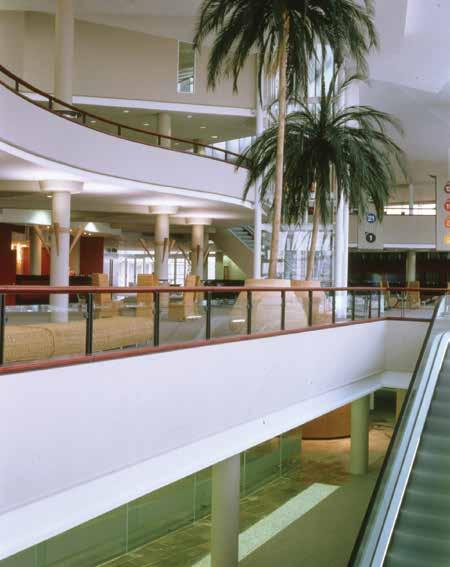
• interact with key decision-makers and industry peers


Sponsor a unique aspect of the conference and enjoy great benefits such as:
• free exhibition stands
• complimentary delegate registrations
• brand representation at the event, promotion of your company in the conference proceedings magazine and online
• free entry for guests at the social evening and much more.
EXHIBITORS
stand NOW
BOOK your
IMESA ORGANISER THE INSTITUTE OF MUNICIPAL ENGINEERING OF SOUTHERN AFRICA (IMESA) TEL: 031 266 3263 DEBBIE OR MELANIE CONFERENCE ENDORSED BY DURBAN INTERNATIONAL CONVENTION CENTRE 83RD IMESA CONFERENCE 02-04 October 2019 SIGN UP FOR A SPONSORSHIP NOW t +27 (031)266 3263 e conference@imesa.org.za conference.imesa.org.za Book online now
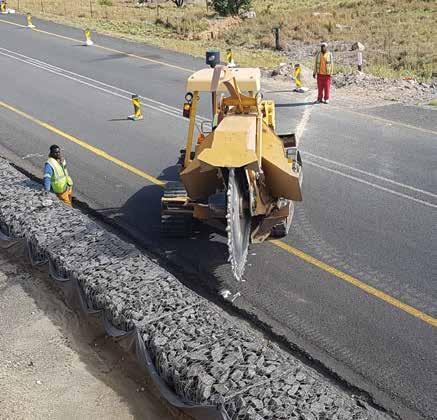
Flexible drainage

As an alternative to conventional drainage, Megaflo provides a number of environmental benefits, including minimal exploitation of quarried material and less spoil.
April 2018 saw the commencement of a special maintenance project in the Eastern Cape, where over 100 000 m of Kaytech’s geocomposite Megaflo panel drain system was used. This 30-month upgrade requires the construction of approximately 100 km of
subsoil drains installed directly along the edge of the existing sealed road surface.
The route stretches from Provincial Route R56 Section 6: Indwe to Elliot and Section 7: Elliot to Maclear.
Due to limited working space, as well as the urgent need to drain the road prism and preserve the layers, the contractor investigated alternatives to conventional drainage construction.
The Megaflo approach proved the most viable in reducing installation times, and eliminated the need for 19 mm stone aggregate.
Wrapped in a bidim geotextile, Megaflo’s HDPE composition provides the optimum combination of high strength and superior filtration. Bidim is a continuous-filament, nonwoven, needle-punched geotextile. Advantages include appreciable thickness,

long

lEFT 1 m deep by 120 mm wide trenches cut in preparation for the subsoil drainage installation
ABOVE Placing selected fill: each Megaflo section is surrounded by a -7.1 mm washed crusher sand with no more than 4% passing 0.075 mm. The sand acts as a pre-filter to protect the geotextile against clogging
high porosity and a high drainage capacity both transverse to and along the plane.
While the high-strength structural core of Megaflo is sufficiently rigid to prevent buckling during installation, its flexibility in the horizontal plane allows for bending around any protrusions. Since Megaflo is also rigid in the vertical plane, a consistent invert gradient is maintained during installation, even if laid at very flat gradients. Megaflo can be installed with minimal bedding, as the ribbed structure and minimum obstruction internal support lugs provide superior crush resistance (>200 kPa).
Installation method
The design was based on a soil permeability of 5 x 10-6 m/s. Varying heights of Megaflo have been installed for the drainage of long cuttings, up to 1 m (500 m in each direction) and at relatively flat gradients (1%).
Using long wooden wedges, Megaflo is either secured in the middle of the trench or along the excavation edge adjacent to the road layers. The trench is then backfilled with the specified washed crusher sand, directly from a modified truck, and hydraulically compacted. Varying sizes of Megaflo have been used. To allow for maintenance and upkeep, rodding eyes are installed at regular intervals.

Subsoil drains have been installed along the road edge, with transverse drains installed through all the cuttings and entrances to the cuttings.
IMIESA May 2019 31 gEOTEC h NICA l E N g INEERIN g
Using
wooden wedges, Megaflo is either secured in the middle of the trench or along the excavation edge adjacent to the road layers
Embracing the revolution –can you afford not to?
The Fourth Industrial Revolution has brought with it technological developments like the internet of things, automation, digitisation and more. While these disruptive technologies are altering the landscape across all sectors, the construction industry often finds itself behind the curve.
by Danielle Petterson
The Fourth Industrial Revolution (4IR), or Industry 4.0, offers a new world of capabilities through data generation and connectivity. The latest technologies ushered in by 4IR offer the benefits of rapid skills developments, risk minimisation and, importantly, the ability to augment capabilities to ensure better quality, efficiency and accuracy.
However, projects in the construction space can take years to progress from conceptualisation to final delivery, often resulting in the sector lagging behind on the technological curve. “When one considers how rapidly technology changes,
this prolonged incubation period requires contractors and professionals to think five years ahead. This is not easily done, and the resulting implication is rapid redundancy in product and process,” explains Dr Marco Macagnano, leader: Smart Real Estate, Deloitte Consulting.
That being said, 4IR has many benefits to offer the industry. New technologies make it possible to integrate processes and project information so that clients, contractors and consulting professionals are able to tap into a centralised database of information.
In doing so, processes can be streamlined, data analysed, forecasts made, operations automated, and accountability improved in an efficient manner.
is wearing the appropriate safety gear and automatically issue a warning to that person or the responsible foreman in real time, a process that would have otherwise taken minutes or hours to respond to can be solved instantaneously,” he says.
“Connectivity means that we now have the tools to have full oversight of the entire supply chain process, workplace safety and productivity, and project programme as it happens.”
BIM

Macagnano argues the value of such systems in an industry that faces a high level of fragmentation and inefficiencies due to the many complex processes that must be managed by numerous stakeholders over extended periods of time.
Furthermore, the potential to reduce risks is enormous.
“When one considers that cameras on a building site can detect if someone

Macagnano argues that building information modelling (BIM) is one of the most powerful technologies available to the construction sector. However, this technology is still somewhat slow to penetrate into the construction space where some of the best benefits could be achieved.
BIM allows users to digitise the construction process in its entirety, making it possible to achieve higher levels of stakeholder integration and collaboration than were previously possible. The software creates a 3D model of a construction project, providing a virtual representation of all elements (such as walls, windows, floor, structure and services) housed in a unified digital environment with detailed associated data.
“A wall is no longer just lines on a paper blueprint, but has embedded information
I N f ORMATION T EC h NO l O gy
32 IMIESA May 2019
Dr Marco Macagnano, leader: Smart Real Estate, Deloitte Consulting
such as materiality, thickness, cost, time to construct, and schedule. Room for error is minimised through automated clash detection, which reduces problems on-site and saves time and cost,” says Macagnano.
“I think it is important to consider that BIM is not an iterative improvement of older processes, but a new technology that exists to revolutionise the construction process. Blueprints of old provided nothing more than a step by step guide of a construction process constrained by the limits of the size of the paper printed upon. A BIM model is a fully integrated digital database that can be interrogated in multiple ways at the discretion of the user such as by material, system, or sequence of construction.”
The digital twin
While BIM is a powerful tool, it is furthered by advancements in what are known as digital twins. These leverage the digitised building model by interrogating the building data on a more advanced level, using artificial intelligence and machine learning.
Macagnano believes that this sophisticated combination of building data, automation and analytics is set to revolutionise the construction sector. This is because digital twins are able to simulate multiple scenarios in an instant to generate improved efficiencies that were not previously possible. Thousands of construction sequence options could
therefore be modelled in a single afternoon. Furthermore, the digital twin becomes a tool for use during building operations. Changing conditions that effect layout, user experience, or energy efficiency can be tested in a simulated environment for improved asset management decisionmaking in the long term.
Virtual reality
Virtual reality (VR) could be considered the next step in the digitisation process, offering users the ability to walk through a space at human scale.
By allowing clients and project stakeholders to gain a preliminary sense of space and design, or interact with the digital model in more complex terms by inspecting structure and services, improved decisionmaking and understanding are possible.
VR also provides a unique opportunity for training and skills development by immersing participants in virtualised environments representative of scenarios that would be difficult to simulate in the physical world. Similarly, augmented reality (AR), which overlays information on our standard field of view via a headset, also offers opportunities for on-the-job training and skills development.
Adapt or die
These and the other technologies ushered in by 4IR make it possible to rapidly improve skills, augment capabilities and
reduce risks, allowing for improved quality and efficiency while reducing errors. The correct deployment of technologies can reduce wastage of materials on-site, and improve workplace safety through realtime monitoring, all translating into a leaner construction process with higher productivity and accountability.
This is particularly important in a difficult economy, where clients and contractors are focused on minimising risk and cost. Macagnano notes that, if correctly undertaken, improvements through technology are the fastest route to improving efficiencies.
“While international markets are already mandating the latest processes through policy, local markets are also growing in expectation for these solutions. A single professional service can ill afford to be the weakest link in the information chain of the overall project team,” he says.
Macagnano prescribes an agile approach that embraces technological advancement for the betterment of processes, facilitated by sophisticated project and change management. Consistent training and development of the workforce are paramount to achieving this and to prevent falling further behind the curve.
“When one considers the immense opportunities and benefits that are offered through these technologies, the question should not be, ‘Can we afford to?’ but rather: ‘Can we afford not to?’”
BIM is not an iterative improvement of older processes, but a new technology that exists to revolutionise the construction process


I N f ORMATION T EC h NO l O gy
IMIESA May 2019 33
Industry 4.0 Holds The Key To Closing The Manufacturing Industry’s Skills Gap
Explore Industry 4.0 strategies and solutions to drive efficiency, productivity and cost benefits in your operations.
Assess what manufacturers are achieving through the implementation of new technologies and implementable real-world solutions
 Organised by:
Organised by:


THE FUTURE OF DIGITISED TECHNOLOGIES
Africa Automation Fair is the premier focused platform for the
Control Industries in the Southern Hemisphere
Connected Industries Conference takes an in-depth look at the Fourth Industrial Revolution
impact it will have on the South African economy. 4-6 June 2019 Johannesburg, Ticketpro Dome
For more information contact us on +27 11 549 8300 REGISTER TO VISIT
Automation and Smart
EXPECT TO BE DISRUPTED
and the
www.africaautomationfair.com
www.connectedindustries.co.za
Three decades of IT innovation






Model Maker Systems was registered as a company to develop and sell software in August 1989. Reaching its 30th year is therefore a very special milestone in a rapidly evolving and highly competitive field that demands the best.
“We’re still going strong, while many other developers in the same field from the 1980s don’t exist anymore, which is testimony to our ability to adapt to the needs of our end users in today’s Industry 4.0 environment,” says Carel Viljoen, CEO and owner, Model Maker Systems.
“Over the years, further development and a policy of providing affordable software, combined with outstanding support, helped us become one of the leading suppliers,” he continues. “We now have nearly 4 000 companies spread over 83 countries using our software. A number of them are leaders in their sectors. Each new generation of surveyors and engineers will be making use of increasingly advanced technology, equipment and methods. In response, we will continue to support them with our future software upgrades and developments.”
Software suite
Model Maker, with its base of survey data from all possible sources and extensive CAD, design and quantification functionality, is now used by: land surveyors; technical surveyors; civil, mining and irrigation engineers; and roads and earthworks contractors.
- Road Maker is used for the design and quantification of all types of roads or any project involving cross-sectional presentation of data.
- Pipe Maker is used for the design and quantification of township pipe services: water, sewer and stormwater.
- Survey Maker has all standard calculations required by surveyors in various applications, but its focus is on cadastral land survey needs to create SG diagrams and Sectional Title diagrams quickly and easily.
- Point Cloud Viewer was developed with the aim to convert point cloud data into more manageable data for conventional DTM software like Model Maker.
“Thanks to their user-friendly and easy presentation, they are highly productive tools in their respective fields of application,” Viljoen explains.
New development project
During 2018, Model Maker Systems embarked on a new development project, which is positioning the business for ongoing growth over the coming decades.
“We will probably start to test this with users early in 2020. This new product will combine our knowledge and experience gained over the last 30 years in one single package, with functionality from all our existing products. Our goal is to ensure that we continue to lead in our sector for another 30 years or more. It’s an exciting and dynamic industry with endless possibilities,” he adds.
“I am sincerely grateful to all the users of our software who have supported us over the years. We’ve made many friends; without these users, we would not be where we are today,” Viljoen concludes.
A South African pioneer in survey and engineering software development, Model Maker Systems is celebrating its 30th anniversary in 2019 and is strongly positioned for ongoing expansion locally and in the international market. IMIESA

I N f ORMATION T EC h NO l O gy
May 2019 35
1667
South Africa’s future socio-economic growth will be mapped out by the surveying profession, providing the framework for security of tenure when it comes to international and domestic investment in land and property. by altus strydom*

Cadastral surveying: What is it and why do we need
The field of cadastral surveying is both fascinating and complex, and is an essential discipline that has its roots in land law with a focus on land tenure, land ownership, land rights and land administration. It ensures clearly defined land parcel demarcations, their ownership and value within both the public and private space.
The responsibilities of the cadastral land surveyor include definining the location and extent of rights in land, the relationship between land rights and the persons who have rights, and restrictions and responsibilities in respect of land. These are also known as the three Rs. Aside from ownership, cadastral surveys are equally essential tools for management of land and infrastructure development, and construction in general. For example, if accurate boundaries of land parcels such as property boundaries, servitudes, mineral rights, service corridors (road, railway, electrical, telecommunications) are not known, it is impossible to update reliable land management and geographic information systems. This is an essential part of urban planning and development for government entities or
any other person occupying land. Plus the cadastral and deeds information confirms who has a vested right, as well as the identification and registration of any real right.
With very few exceptions, most countries (even communist nations) have a cadastral system delineating and defending their internal and external boundaries. In Africa, some countries did away with
their cadastral systems after gaining independence, but most have returned to a system based on survey since there is no viable alternative. Mozambique is a prime example. People in general, especially rural communities, want to know where their boundaries are. The cost of litigation in case of disputes is impossible to bear.
South African surveyors (also referred to as geomaticians) are governed by the

36 IMIESA May 2019 gEOMATICS
Carports Carports Carports Carports 1 2 5 6 7,8 9,10 11,12 13,14 44 43 35 34 98m2 98m2 98m2 98m2 98m2 94m2 94m2 94m2 94m2 94m2 65m2 65m2 65m2 65m2 Stairs Toilets Refuse 5.00m ERF 1723 ERF 1724 ERF
ERF
ERF
A D E Thekisho Road 8.64m 8.88m Guard House Store 7.92m *Altus
Northern
South African Geomatics Institute
it?
1668
1666
Strydom is the chairperson:
Provinces,
recently published Geomatics Professions Act (No. 19 of 2013) and are regulated by the South African Geomatics Council (SAGC). It is important to note that this Act clearly defines that only persons registered as professional land surveyors with the SAGC may engage in surveys related to demarcation of boundaries.
In South Africa, all parcels of land are surveyed and lodged with the Surveyor General (SG). The Land Survey Act (No. 8 of 1997) controls the surveying of land parcels.
Thekisho Road
Ownership provides title holders with the right to use land to its full potential: sell it, use it as security for a loan, exclude its use by others, or lease it. A lease for ten years or more is a “long lease” and must be registered.
Survey documents
The diagram and general plan are the fundamental registerable documents prepared by the land surveyor. Essential information includes the property description, listing the coordinates of corner beacons, details of any curvilinear boundary, servitudes affecting the property and the area of the property.
In each parcel, a unique 21-character key is allocated. Upon registration at the Deeds Office, the diagram is attached to a title deed.
There are numerous types, such as:
• diagrams for a single portion of land
• general plans for new townships or several pieces of land
• servitude diagrams for registering servitudes over an existing property
• lease diagrams for registering long leases over portions of properties
• consolidation diagrams when it is required to consolidate several individual properties into one, taking out certificates of consolidated title
• mineral diagrams to register mineral rights separately from the land rights
• mining title diagrams for registering the right to extract minerals from the land. With the exception of mining title diagrams, which are registered with the Department of Minerals and Energy, these diagrams are registered together with their deeds in a Deeds Registry.
Sectional titles
The Sectional Titles Act (No. 95 of 1986) controls the registration of units in a building. This means that a person or entity can register ownership of part of
a building in his/her/its name. Again, the process is administered by a survey, SG approval and registration in the deeds office. Units in a scheme can be subdivided, consolidated and extended.
It is important to note that adherence to existing town planning schemes and approved building plans are prerequisites to SG approval. The land surveyor must certify that these are correct prior to lodgement with the SG. Illegal additions to buildings are a major concern for municipalities because they create potential fire hazards. They do not have electrical compliance certificates, while structural defects could affect the safety of occupants.

When to appoint a surveyor
Before any planner, project manager, engineer, or administrator can start planning, they need an up-to-date plan to show:
• existing property boundaries
• all other rights that affect the property such as servitudes, proclamations and leases
• existing contours
• all buildings, roads, fences, power lines and other structures that might affect the planning process.
Where redevelopment takes place, it is also necessary to find and map underground services, such as sewer pipelines, and electric and fibre optic cables.
This work can be executed by airborne lidar, ground-based lidar, GPS, conventional survey or underground services detection equipment. These are all supported by advanced technologies and are quick to implement. As an aside, even in the 1980s, aerial survey techniques were being used to conduct major cadastral surveys of townships and cities. The biggest obstacle with aerial survey is that not all of the important details can be captured. For this reason, a ground survey is still necessary to supplement the aerial survey. Today, we can deploy drones and overlap the data captured from the air with ground data to achieve a perfect result.
The future
At this stage, the benefits of sound cadastral surveys and land registration are not readily available to many of our traditional communities, particularly in remote rural areas. In order to address
this, innovative alternative forms of cadastral surveys and land tenure have been developed by the profession. These new systems are affordable and secure, as modern survey techniques have enabled us to reduce the cost of surveying without compromising accuracy or reliability. In keeping with international trends, the day is in sight when the separation of cadastral maps and plans from land registers will be abolished. The national cadastre will then be managed as one digital entity.
Outside the formal sector, one area where the surveying profession could make a major contribution is in the informal housing segment. Uncontrolled occupation and squatting on public land is a common challenge for municipalities, which impacts on the coordination and execution of urban spatial planning.
An alternative approach would be to survey, establish and fence off future infrastructure corridors within land parcels allocated for informal communities. The registration and allocation of individual title deeds can come later, along with formal housing and services. That’s a controlled approach that would work.
Cadastral surveys are the past and the future. They provide absolute certainty and ensure the fair and accurate billing of property owners. They also provide the only workable and legal foundation for land allocation and development. Property rights are also a proven catalyst for investment and growth.

Carports Carports Carports Carports Carports Carports Carports Carports Carports Carports 1 2 3 4 5 6 7,8 9,10 11,12 13,14 15,16 17,18 19 20 44 43 42 41 40 39 31 30 29 98m2 98m2 98m2 98m2 98m2 98m2 98m2 94m2 98m2 98m2 94m2 94m2 94m2 94m2 94m2 94m2 94m2 94m2 94m2 65m2 65m2 65m2 65m2 65m2 Stairs Toilets Refuse 8.59m 5.00m ERF 1724 1668 1667 A D E
8.64m 8.88m Guard House Store 7.92m
gEOMATICS IMIESA May 2019 37
Carports Carports Carports Carports Carports Carports Carports Carports Carports Carports 15,16 17,18 19 20 22 33 32 31 30 29 28 27 26 25 94m2 94m2 94m2 98m2 98m2 94m2 94m2 94m2 94m2 98m2 98m2 98m2 98m2 65m2 65m2 Stairs 5.72m 4.86m 1724 C Mandela Dr www.sagi.co.za
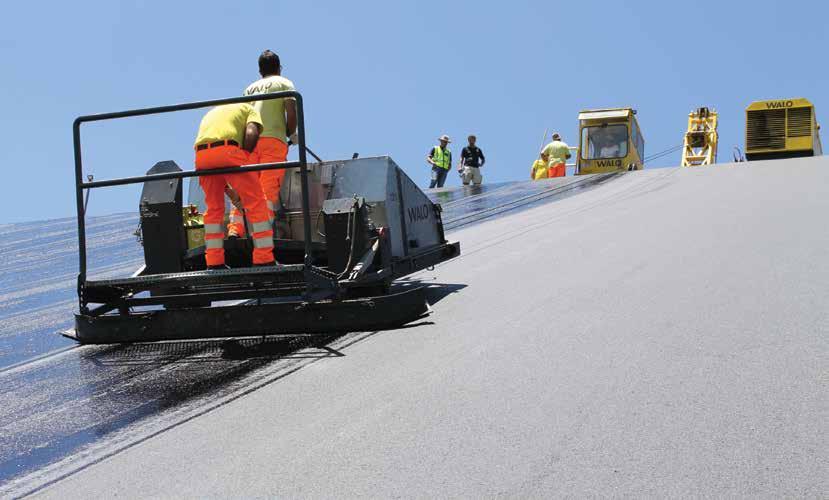
Resealing Von Bach Dam
The Von Bach Dam is the backbone of the water supply for Windhoek, Namibia. With the dam’s brittle asphaltic seal in need of urgent replacing and the rainy season fast approaching, the Namibia Water Corporation was under pressure to repair the dam.


Von Bach Dam is a concretefaced rockfill dam (CFRD) with a specially designed hydraulic asphaltic seal. Asphaltic-faced rockfill dams are uncommon across Africa, which only houses approximately five similar dams, two of which are in Namibia.
Tests on the dam’s old asphaltic seal indicated that the brittle asphalt had to be replaced as soon as possible, and to an elevation as low as possible to optimise the repair effort. After a three-year drought the dam’s water reached approximately 10% – its lowest level in 20 years. This provided an ideal window of opportunity to rehabilitate the deteriorated asphaltic seal, which forms the watertight membrane of the dam.
Racing the clock
Time was of the essence for the project team as failure to successfully complete the project before the next rainy season could result in water shortages, which would have dire consequences for Windhoek’s water users and the economy.
PRoject teAm
Client: Namibia Water Corporation (NamWater)
Consulting engineer: Knight Piésold
Contractor: WALO International subcontractor: Much Asphalt

Planning the project was a balancing act for consulting engineering firm Knight Piésold. The projected dam levels and rain inflows had to be considered together with the shipping and site establishment of imported construction machinery.
Specialised expertise was required to fasttrack this project, with under three months available to demobilise the construction plant in Europe, ship it to Namibia, arrange temporary import clearance and taxes, establish equipment on-site, and complete the work.
The project’s complexity lay in the logistical arrangements to import the
D AMS & WATER S TORA g E
38 IMIESA May 2019

specialised construction equipment, arrange import taxes and clearances, work visas for foreign staff, get the asphalt plant operational, finalise the mix design, and get the project completed before the main onslaught of the approaching rainy season.
Completing the project required milling away a significant portion of the old asphalt membrane and replacing it with a new 70 mm thick asphaltic drainage layer as well as a new 70 mm thick dense asphaltic seal.




Batching of the new asphalt was performed by subcontractor Much Asphalt at its batching plant at the Aris Quarry, south of Windhoek. Much Asphalt has recently installed a new plant, located at the Kunene Building Supplies quarry at Aris, which started commercial supply of asphalt in April 2019. The plant incorporates a fully functional asphalt laboratory and produces medium continuously graded asphalt, bitumen-treated base and fine mix.
Much Coldmix is also supplied in bulk or 25 kg bags, which can be exported from



ACCOUNTABLE FOR QUALITY

We don’t just promise quality. We hold ourselves accountable for it. Process control laboratories at every plant and on site continually monitor and test our processes and products. Our customers can rest assured they are placing and compacting quality asphalt.


the Namibian operation to Angola and Zambia. In addition, Much Asphalt Namibia can manufacture complex and proprietary mixes, such as those required for the Von Bach Project as well as Hosea Kutako International Airport.
Benefits of an asphalt seal
Several CFRDs in Brazil and Lesotho have experienced embankment settlement, leading to the rigid concrete layers rupturing under concentrated compressive force, and therefore failure to contain water. Asphalt is unique in its ability to absorb settlement without cracking and act more like a flexible membrane than a rigid concrete shell.
Repairing Von Bach Dam’s asphalt face with a new asphalt seal, as opposed to a plastic membrane or conventional concrete, was therefore recommended. Asphalt contains volatiles that escape when exposed to UV rays and the atmosphere. This can lead to increased brittleness and cracking of the asphalt


D AMS & WATER S TORA g E
Much Asphalt is southern Africa’s largest manufacturer of hot and cold asphalt products. A B-BBEE Level 1 Contributor T: +27 87 230 7597 (NAMIBIA) | +27 21 900 4400 (HO) E: info@muchasphalt.com | www.muchasphalt.com incorporating QUALITY
A strong foundation for infrastructure success





ROCLA is South Africa’s leading manufacturer of pre-cast concrete products. Surpassing 100 years of product excellence, including pipes, culverts, manholes, poles, retaining walls, roadside furniture, sanitation and other related products within infrastructure development and related industries.
surface. However, asphalt covered by water for a large percentage of the time is typically in better condition than the asphalt above water level.
In a dry environment such as Namibia, where the dam’s water level frequently drops to below 50%, a large portion of the asphalt is exposed to natural elements. To counter the escape of volatiles, a sacrificial mastic seal layer of 2 mm to 3 mm of specific bitumen/filler mix is spread over the asphalt seal. This mastic layer needs replacement every 10 to 15 years to ensure that the dense asphalt layer underneath remains protected and crack-free.
The Von Bach Dam seal design includes the protective mastic coating, as well as operational guidelines for inspections and replacement of the mastic layer when required.
If the client operates and maintains the new asphaltic seal and mastic coat according to the recommended operational guideline, the seal’s longevity should be ensured, beyond the roughly 45 years the original seal provided.
Difficult work conditions
The steep slope of the dam posed a challenge in the removal and replacement of asphalt. No vehicle had sufficient traction to work on the steep slopes with a smooth asphalt surface, without damaging the asphalt. Heavy mobile winches were therefore employed to control the movement of construction equipment up and down the face of the dam.
The winches travelled horizontally along the crest road of the dam, from side to side, while the asphalt milling and paving machines travelled in a vertical direction – up and down the face of the embankment. The tracked milling and paving machines had pads installed between the ridges of the tracks to ensure even distribution of the machine weight on to the asphalt, to avoid damaging the surface.
The preparation of joints on the sides of the embankment also required a mobile working platform equipped with bitufill-oven and jointing materials, and jointing required manual labour by a team with experience in hydraulic asphalt seals.
Project success
Effective teamwork by all parties led to successful project completion within the set time frame. The completed dam started receiving inflow within two weeks of completion; within two months, the dam was at 60% capacity, inundating the newly placed seal.
The leakage rate of the dam has been reduced by nearly 50%, indicating that the old seal had likely been losing water through cracks. The new seal has also reduced the risk of failure and increased the operational life of the dam.

Visit us on www.rocla.co.za for our nationwide branches
Mastering cold weather concreting

Despite South Africa’s relatively mild winters, placing concrete during cold weather conditions can pose challenges, especially in mountainous regions. bryan Perrie expands on important factors to consider.
Weather in the concrete industry is regarded as cold when the ambient temperature falls below 5°C. This does not generally happen during the day in most parts of South Africa, which means expensive preventative measures, such as heating aggregates, are seldom necessary.
The effect of concrete freezing at early ages depends on whether the concrete has set, and the strength attained when freezing took place. If unset concrete is allowed to freeze, an increase in the overall volume of the concrete occurs due to the expansion of
The main requirement in cold weather concreting is to prevent heat loss of the freshly placed concrete.”
water, especially in the capillary pores. When thawing takes place, the concrete will set with an enlarged volume of pores, which will reduce strength and durability.
If freezing takes place after the concrete has set, but before it has gained sufficient strength (about 3 MPa to 5 MPa), expansion associated with the formation of ice will disrupt the microstructure and cause irreparable loss of strength and durability.
When the concrete has achieved a compressive strength of at least 3 MPa to 5 MPa, it can resist a freezing cycle without damage because it has a higher resistance to the pressure of ice. Plus, a large part of the mixing water will either have combined with the cement or will be located in gel pores and, therefore, unable to freeze.
Key points
Consideration should be given to the following when concreting in cold weather: • cement type: Because of their slower setting and rate of strength gain, the use of highly extended cements or the
partial replacement of CEM I cement with significant amounts of either groundgranulated blast furnace slap or fly ash is not recommended. It may be advantageous to use CEM I 42.5R or 52.5N cement in preference to 42.5N or 32.5N cements.
• aggregate protection: Water in aggregates may be prevented from freezing by covering stockpiles with tarpaulins. If aggregates

Bryan
Perrie,
managing director, The Concrete Institute
IMIESA May 2019 41 C EMENT & C ONCRETE
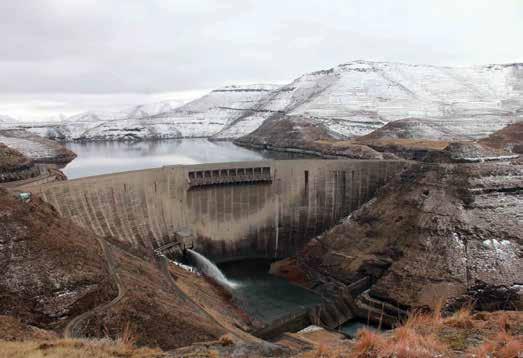
are likely to become frozen or contain ice and snow, they may have to be heated with steam injection or hot air blowers. When using steam heating, adequate drainage must be provided. Typically, the aggregate should be heated to between 10 ° C and 20°C.
• lagging of water pipes: All water pipes must be adequately lagged to prevent supply pipes from freezing, or even bursting.
• heating mixing water: The most common and easiest way to heat concrete is to heat the mixing water, but care must be taken not to exceed 60°C to 70°C. At higher temperatures, flash-setting of the cement and reduced workability may occur.
• batching and mixing: Adequate protection must be given to the batching and mixing plant, as the concrete temperature can drop significantly if the equipment is very cold.
Crash-tested

Concrete barriers in the median or along the verge of a roadway or bridge often go unnoticed until an unexpected collision occurs, which is when the role and importance of these vehicle restraint systems (VRS) really becomes evident.
Within this field, Austrian pioneer Rebloc is regarded as a leader in precast concrete road barrier technology and is represented in Southern Africa by Rocla as the exclusive licence holder.
• concrete temperature: The minimum concrete temperature as mixed should be higher in colder conditions, but may be reduced for concrete placed in larger sections. For air temperatures between -18°C and 0°C, recommended concrete temperatures vary between 7°C and 18°C.
• transporting and placing: As significant heat losses occur during these processes, they must be carried out quickly. Unless the concrete is adequately protected, methods of transport such as conveyors and chutes are not recommended.
Finally, the main requirement in cold weather concreting is to prevent heat loss of the freshly placed concrete. So, under no circumstances should water-curing methods be used. Heat may be retained by using insulated forms, covering exposed surfaces with insulating materials, or erecting covers with internal heating. Combustion-type heating under covers should be avoided.
Formwork and props must be left in place longer than for normal weather, and pedestrian and vehicular traffic will also have to be kept off slabs for longer than usual.
this full list – from the lowest to highest containment levels.
To obtain certification, each barrier system needs to be crash-tested. This provides the opportunity to observe critical data relating to barrier movement, passenger safety and also to confirm that the system does not break up, preventing vehicles from passing through into oncoming traffic.

The Rebloc suite includes a patented coupling and tension bar system, cast into the concrete and creating a continuous barrier chain. This is capable of absorbing and distributing the large energy forces associated with a vehicle collision.
European and South African codes EU 1317 and SANS 51317, respectively, provide a list of different collision scenarios to be used by vehicle restraint system designers and roads engineers. Rebloc has a range of products to accommodate
“The replacement of barrier elements is generally only required if the concrete has spalled to an extent that the reinforcement within the barrier is visible,” explains Justin Kretzmar, group sales engineer, Rocla. Rebloc vehicle restraint barriers have been crash-tested in Europe with real vehicles, in order to conform to the EN code requirements and obtain, among other things, the ‘working width’ and ASI (Acceleration Severity Index) data specific to each barrier system and containment level tested.
“The Rebloc system, with its low maintenance and vandal-proof design, is perfectly positioned to make our roads a safer place,” Kretzmar concludes.
C EMENT & C ONCRETE 42 IMIESA May 2019
Rocla has supplied Rebloc systems on numerous projects across South Africa and Botswana, some of which have successfully sustained a considerable number of collisions



























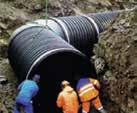


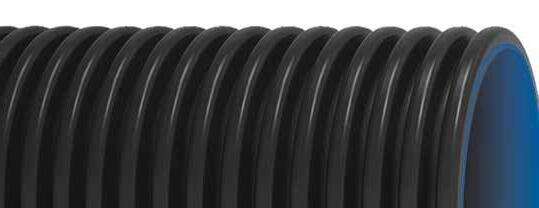



Connecting countries and economies
The use of precast techniques provides an optimum solution for a remote river crossing designed to forge socio-economic links between South Africa and Botswana.
Anew river bridge being constructed at the Platjan border post will greatly improve traffic flows, stimulating the development of industries and small businesses in key towns like Selibi Phikwe. It will now also relieve congestion at the Martin Drift border post, situated further to the south-west.
The new structure replaces a narrow, low-level bridge that is often flooded during heavy rains, seriously inconveniencing communities and businesses on both sides of the border.
The Selibi Phikwe Economic Diversification Unit, an investment company established by the Botswana government to diversify Selibi Phikwe’s predominantly mining economy, is the project facilitator. Among the beneficiaries will be small farmers in the Bobirwa district and tourism-related industries that have developed around attractions at the Letsibogo, Dikgatlhong and Thune dams.
Botswana-based Estate Construction was appointed to build the bridge, with the works being supervised by local consulting engineer ACE GIBB. Construction commenced in January 2018 for scheduled completion in June 2019.
The bridge is more than 9 m high, 155 m in length and 12.7 m wide, and comprises two 3.7 m wide traffic lanes in either direction and 2.5 m wide pedestrian walkways on both sides of the carriageway.
Precast design
By March 2019, Estate Construction was already forging ahead with the installation of the few remaining precast-concrete T-beams and the fixing of the 120 t steel reinforcing for the bridge deck.
The 10 bridge spans each comprise 21 beams, 15.5 m in length and 800 mm deep. They were manufactured and installed by CoreCivils, a joint venture between CoreSlab and Corestruc.
“We visited a number of manufacturers’ factories ahead of construction to witness for ourselves the processes that they deploy. Estate Construction was very impressed with the quality controls in place at CoreCivils’ factory and decided to appoint the company as its bridge beam supplier,” says Julius Katzke of Estate Construction.
Considering the limited space on-site, the bridge beams were manufactured ahead of their installation and stored at the factory. Five elements per load were then dispatched to site. On arrival,
they were lifted directly from the truck trailers and placed on top of the 1 m wide and 9 m high tapered piers using a 30 t mobile crane. The crane, which was supplied by CoreHire, is positioned on a coffer dam that was built during the construction of the bases of the structure: the existing bridge is too narrow to accommodate the machine with its outriggers fully extended.
Staged construction
105x148_ad.pdf 1 2019/04/16 11:24:49 AM
Corestruc’s team started working from the South African side of



C M Y CM MY CY CMY K
May 2019 45
IMIESA
C EMENT & C ONCRETE
We visited a number of manufacturers’ factories ahead of construction to witness for ourselves the processes that they deploy. Estate Construction was very impressed with the quality controls in place at CoreCivils’ factory and decided to appoint the company as its bridge beam supplier.”
the bridge, completing two spans a day, while Estate Construction commenced installing the 120 t of reinforcing bar for the deck. Once the centre portion has been cast, Estate Construction will easily access the bridge with a truck-mounted boom crane to complete the side sections, with the precastconcrete bridge barriers serving as a shutter. Close attention will also need to be paid to

the drilling of the 80 mm diameter core holes that accommodate the drainage pipes and service ducts. The bridge will then receive a 60 mm thick asphalt layer. The two concrete pavement approach roads also form part of the final phases of the project.
CoreFleet ensured the timely delivery of the many precast-concrete elements to site, located more than 150 km from
The perfect seal

ACoreSlab’s factory in Polokwane. All of the 3 200 m3 of 35 MPa concrete for the main bridge structure was produced on-site by Estate Construction.
Jaco de Bruin, managing director of CoreSlab, complimented Estate Construction for their stellar workmanship on a project that is set to benefit so many businesses and communities when completed.
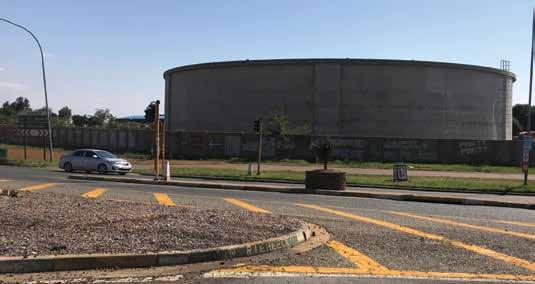


The internal joints of the reservoir underwent a waterproofing exercise to prevent the unit from leaking
high-performance joint sealing system supplied by Sika was used in the development of a new 25 Mℓ reservoir in Kempton Park. The project was completed by main contractor
The project scope included considerable work to the walls and columns for both construction and expansion joints, as well as strengthening of the reservoir floor joints
WK Construction and forms part of a series of infrastructure upgrades being undertaken by Ekurhuleni Metropolitan Municipality. Applied by subcontractor Con-Solve Civils, Sika’s Sikadur-Combiflex SG bandage system was used to seal the wall and floor joints in the final stages of the project. This high-performance joint sealing system consists of a flexible polyolefin waterproofing tape and Sikadur epoxy adhesive, which was
Ekurhuleni’s new 25 Mℓ reservoir
Sikadur-31 DW, in this case. As a highly specialised waterproofing system, SikadurCombiflex SG is used for expansion and connection joints, as well as cracks. When fixed to the joint, it allows for irregular and significant movement in more than one direction, while maintaining a highquality seal.
C EMENT & C ONCRETE
46 IMIESA May 2019

Leading in the 20 t class
From the outset, Komatsu’s PC210 design philosophy has been based on producing a robust machine that is simple and cost-effective to maintain. This has been refined on each successive model.
Komatsu’s new PC210-10MO hydraulic excavator builds on the legendary reputation of the previous-generation PC200-8MO unit and comes to market with a host of performance improvements.
“Simply put, the PC210-10MO is more productive, powerful and economical than its predecessors against a background of improved operator safety and comfort, together with the latest cab-based information technology. This takes a product, which has always delivered, to the next level,” says Mike Helm, GM: Marketing and Sales, Komatsu South Africa.
The bucket size has been increased to 1.2 m³, while the lifting capacity has
The PC210-10MO’s bucket size has been increased to 1.2 m³, while lifting capacity has received a 5% boost





You asked for more power and productivity.
Komatsu introduces the new and improved PC210-10MO.
Promising more productivity, more power, more safety, and increased fuel efficiency to give you the market-leading 20 tonne hydraulic excavator.



Proving 100 years of engineering expertise can’t be wrong. m re 15 TRAVEL POWER



m re 20 BUCKET CAPACITY


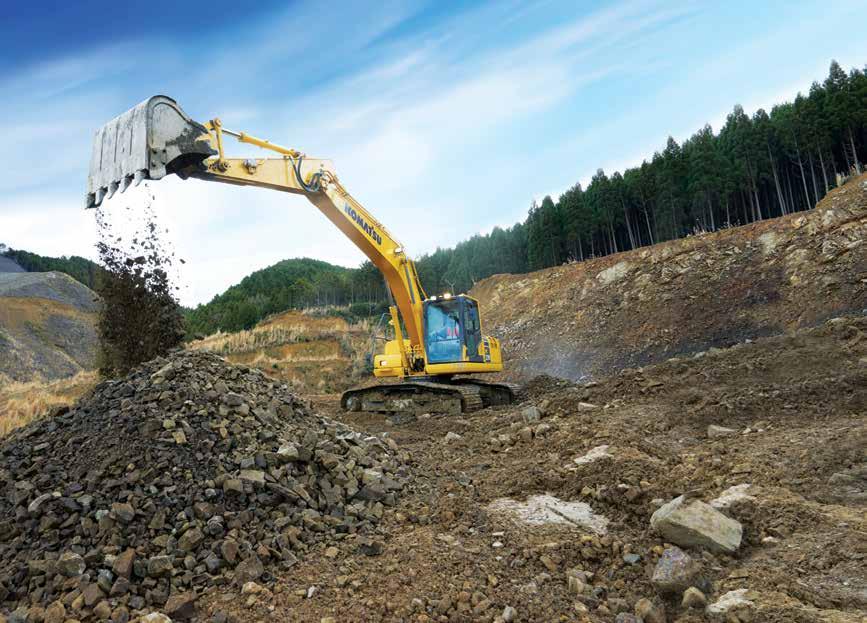
T RANSPORT, lO g ISTICS , vE h IC l ES & Equ IPMENT
Pre-order now: info @komatsu.co.za www.komatsu.co.za . +27 87 945 1000
EFFICIENT
m re 12 ENGINE POWER m re 20 FUEL


e fficiency g A ins
new PC210-10Mo vs previous-generation PC200-8Mo model
• Lifting capacity: up 5%
• Engine power: up by 12%
• Travelling output power: 15% improvement
• Fuel consumption: 20% improvement
• Bucket capacity increased to 1.2 m³
• Improved stability thanks to a heavier counterweight and extended rear tail radius
• Hydraulic oil filter element replacement interval extended from 1 000 to 2 500 hours
• Safer cab with Komatsu’s class-leading KomVision 360-degree view

risen by 5% thanks to the greater stability provided by a heavier counterweight and extended rear-end radius.
Greater digging power is provided by an engine that has been designed to deliver a 12% gain in power, now producing 123 kW. It also features a P-mode setting, which, at the touch of a button, provides maximum digging power in a single, controlled burst. Travelling power output has also climbed by 15%, delivering improved traction and reduced tramming times when traversing inclines, gradients and tough terrain.
These increases in performance are accompanied by an equally impressive 20% improvement in fuel economy due to enhanced engine management technology, which includes optimised fuel-injection controls. Further gains have been achieved by reducing hydraulic pressure loss and fan speeds. Cab instrumentation also plays a role, as alarms warn the operator of
excess idling as well as signify the machine’s operational modes.
Lower maintenance costs
There is easy access to engine oil and lubrication system filters, which are integrated to be positioned on one side of the machine. Another major enhancement that will be welcomed by maintenance crews is the extension of replacement cycle times for hydraulic oil filters from 1 000 to 2 500 operating hours.
An important safety feature is the single battery disconnect switch, which enables the service technician to disengage the power supply and lock out before conducting maintenance work.
Operator safety is the first priority on this new product. A key, new safety feature are two rear-mounted cameras that transmit images to the control panel, providing the operator with a 360-degree view of the site at all times.

48 IMIESA May 2019
Komatsu’s Komtrax remote machine monitoring system feeds back key data such as mechanical health and in-field utilisation
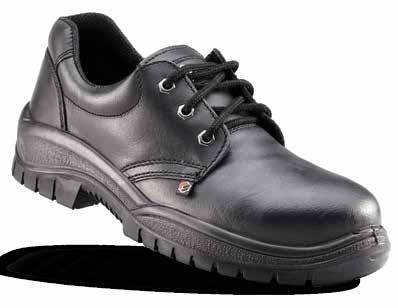



Ultimate multitaskers
acker Neuson’s two new skid-steer loaders offer the power and performance needed to deliver multitasked solutions on-site. They feature a class-leading hinge pin height on the vertical lift loader, which provides maximum loading and unloading capabilities.
An engine torque of 308 Nm provides the power needed for improved groundengaging performance in all kinds of terrain. The Kohler diesel engine features a zeromaintenance and regeneration-free exhaust emission treatment system, eliminating the impact of extreme heat, as well as the need for filters. With a fuel tank capacity of 113 ℓ, the operator is able to spend more time in the cab and less time refuelling.
“Versatility comes standard with every Wacker Neuson loader. The universal skidsteer attachment plate enables attachments to be switched out easily, accomplishing

With a best-in-class one-year/1 000-hour bumper-to-bumper warranty, as well as a transferable engine warranty of four years or 4 000 hours, these new models are ideal for inventory management and resale
more in less time. Category-leading hydraulic horsepower is standard,” says Dennis Vietze, managing director, Wacker Neuson South Africa.
Wacker Neuson has created a cab environment with operator comfort and convenience in mind. Access in and out is easy: there is no restrictive lap bar and controls are intuitively placed. Additionally,

these machines offer the market’s only onepiece, pod-style cab that fully tilts forward with the lift arms down, providing complete access to all maintenance components.
Wacker Neuson’s new skid-steers are available as either radial or vertical lift machines. They were designed and are being built at the OEM’s production plant in Menomonee Falls, USA.











Grab your target market’s attention on www.infrastructurenews.co.za OVER 100 000 visitors every month Use our rich media solution – video, animation and text – to reach and engage with your target market. Digimags Newsletters Website Print and digital solutions for business communities www.3smedia.co.za ADVERTISE Jenny Miller on +27 (0)11 467 6223 or jennymiller@lantic.net SUBSCRIBE TO DIGIMAG +27 (0)11 233 2600 or subs@3smedia.co.za SIGN UP FOR NEWSLETTER www.infrastructurenews.co.za Complete water resource and wastewater management Water & Sanitation Africa + + FOLLOW US infrastructurenews @infrastructure4 W
T RANSPORT, lO g ISTICS , vE h IC l ES & Equ IPMENT

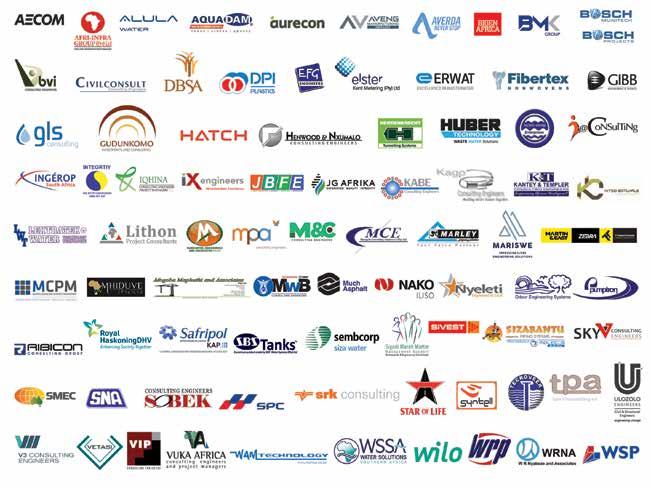
PROFESSIONAL AFFILIATES
AECOM siphokuhle.dlamini@aecom.com
Afri-Infra Group (Pty) Ltd banie@afri-infra.com
ALULA (Pty) Ltd info@alulawater.co.za
AQUADAM (Pty) Ltd sales@aquadam.co.za
Aurecon Fani.Xaba@aurecongroup.com
Aveng Manufacturing Infraset werner.booyens@infraset.com
Averda claude.marais@averda.com
Bigen Africa Group Holdings otto.scharfetter@bigenafrica.com
BMK Group brian@bmkgroup.co.za
Bosch Munitech info@boschmunitech.co.za
Bosch Projects (Pty) Ltd mail@boschprojects.co.za
BVI Consulting Engineers marketing@bviho.co.za
Civilconsult Consulting Engineers mail@civilconsult.co.za
Corrosion Institute of Southern Africa secretary@corrosioninstitute.org.za Development Bank of SA divb@dbsa.org.za
DPI Plastics Farhana@dpiplastics.co.za
EFG Engineers eric@efgeng.co.za
Elster Kent Metering Leonardus.Basson@honeywell.com
ERWAT mail@erwat.co.za
Fibertex South Africa (Pty) Ltd maru@fibertex.co.za
GIBB marketing@gibb.co.za
GIGSA secretary@gigsa.org
GLS Consulting nicky@gls.co.za
Gudunkomo Investments & Consulting info@gudunkomo.co.za
Hatch Africa (Pty) Ltd info@hatch.co.za
Henwood & Nxumalo Consulting Engineers (Pty) Ltd pmboffice@hn.co.za
Herrenknecht schiewe.helene@herrenknecht.de
Huber Technology cs@hubersa.com
Hydro-comp Enterprises info@edams.co.za
I@Consulting info@iaconsulting.co.za
INGEROP mravjee@ingerop.co.za
Integrity Environment info@integrityafrica.co.za
IQHINA Consulting Engineers & Project Managers info@iqhina.co.za
iX engineers (Pty) Ltd hans.k@ixengineers.co.za
JBFE Consulting (Pty) Ltd issie@jbfe.co.za
JG Afrika DennyC@jgafrika.com
KABE Consulting Engineers info@kabe.co.za
Kago Consulting Engineers kagocon@kago.co.za
Kantey & Templer (K&T) Consulting Engineers ccherry@ctokamteys.co.za
Kitso Botlhale Consulting Engineers info@kitsobce.co.za
Lektratek Water general@lwt.co.za
Lithon Project Consultants (Pty) Ltd info@lithon.com
Makhaotse Narasimulu & Associates mmakhaotse@mna-sa.co.za
Malani Padayachee & Associates (Pty) Ltd admin@mpa.co.za
M & C Consulting Engineers (Pty) Ltd info@mcconsulting.co.za
Maragela Consulting Engineers admin@maragelaconsulting.co.za
Marley Pipe Systems info@marleypipesystems.co.za
Mariswe (Pty) Ltd neshniec@mariswe.com
Martin & East
gbyron@martin-east.co.za
Masithu Consulting & Project Management info@mcpm.co.za
Mhiduve adminpotch@mhiduve.co.za
Mogoba Maphuthi & Associates (Pty) Ltd admin@mmaholdings.co.za
Moedi Wa Batho Consulting Engineers (Pty) Ltd info@wabatho.co.za
Much Asphalt bennie.greyling@muchasphalt.com
NAKO ILISO lyn.adams@nakogroup.com
Nyeleti Consulting merasmus@nyeleti.co.za
Odour Engineering Systems mathewc@oes.co.za
Pumptron randall@gormanrupp.co.za
Ribicon Consulting Group (Pty) Ltd info@ribicon.co.za
Royal HaskoningDHV francisg@rhdv.com
SABITA info@sabita.co.za
SAFRIPOL mberry@safripol.com
SALGA info@salga.org.za
SAPPMA admin@sappma.co.za / willem@sappma.co.za
SARF administrator@sarf.org.za.co.za
SBS Water Systems mava@sbstanks.co.za
Sembcorp Siza Water info-sizawater@sembcorp.com
Sigodi Marah Martin Management Support lansanam@sigodimarah.co.za
SiVEST SA garths@sivest.co.za
Sizabantu Piping Systems (Pty) Ltd gregl@sizabantupipingsystems.com
SKYV Consulting Engineers (Pty) Ltd kamesh@skyv.co.za
SMEC capetown@smec.com
SNA stolz.j@sna.co.za
Sobek Engineering gen@sobek.co.za
Southern African Society for Trenchless Technology director@sasst.org.za
Southern Pipeline Contractors (Pty) Ltd spc@vinci-construction.com
SRK Consulting jomar@srk.co.za
STAR OF LIFE EMERGENCY TRADING CC admin@staroflife.co.za
Syntell julia@syntell.co.za
TECROVEER (Pty) Ltd info@tecroveer.co.za
TPA Consulting roger@tpa.co.za
Ulozolo Engineers CC admin@ulozolo.co.za
V3 Consulting Engineers (Pty) Ltd info@v3consulting.co.za
Vetasi south-africa@vetasi.com
VIP Consulting Engineers esme@vipconsulting.co.za
VUKA Africa Consulting Engineers info@vukaafrica.co.za
Water Institute of Southern Africa wisa@wisa.org.za
WAM TECHNOLOGY CC support@wamsys.co.za
Water Solutions Southern Africa ecoetzer@wssa.co.za
Wilo South Africa marketingsa@wilo.co.za
WRP ronniem@wrp.co.za
WRNA washy@wrnyabeze.com
WSP Group Africa ansia.meyer@wsp.com
IMESA AFFILIATE MEMBERS
IMESA

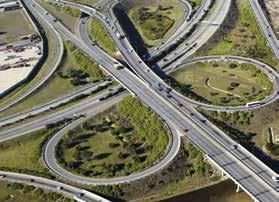


INDE x TO AD v ERTISERS African Automation Fair 34 AfriSam South Africa OFC Ammann Construction Machinery OBC APE Pumps 13 BBF Safety Group 49 Corestruc 45 Corobrik 9 ELB Equipment 48 ERWAT 2 Grundfos 24 IMESA 22, 30, 51 ISUZU Truck SA 43 JG Afrika 17 Komatsu Southern Africa 47 Model Maker Systems 35 Much Asphalt 39 Nyeleti Administration Trust 18 OPECS 10 Old Mutual 26 Rocla 40 South African Geomatics Institute 36 Sizabantu Piping System IBC Southern Pipeline Contractors 44 Totally Concrete 52 Utility Week Insert UltraTech 20 11 - 13 June 2019 Gallagher Convention Centre Johannesburg, South Africa • Reach 2 Million Prospective Buyers • 36 Years of Experience in Organising Events • Dedicated Exhibitor Marketing Services • Unparalleled Networking Opportunities • Strong Government Alliances Benefits of exhibiting with us Grow your business in Africa’s multi-billion construction sector www.africanconstructionexpo.com Organised by: BOOK YOUR STAND TODAY MarcelDuToit@dmgevents.com +27 21 700 5500 Get in touch to get a tailored exhibiting or sponsorship package to ensure that you achieve the maximum benefits from the expo.
52 IMIESA May 2019


MATURE PLANT CONCEPT
AMMANN CBT 60 ELBA CONCRETE-MIXING PLANT
Fast installation times and unproblematic relocation as well as favourable transport dimensions for were the main targets of the engineers developing the new plant concept. Result is the new Ammann CBT plant, that is extremely fast in set up times due to its folding mechanisms and compact plant design.
• No foundations needed, soil compaction of 250 kN/m² is sufficient
• Plug & Play – Plants electric and pneumatic components are completely pre-installed
• Simple transport
• Theoretical output capacity of 60 m³/h
• Short assembling times
Ammann Construction Machinery, Unit 3 Great North Industrial Park, 20 van Wyk Road Brentwood Park, Benoni 1500, South Africa, Tel. + 27 11 849 3939, Fax + 27 11 849 8889, info.aza@ammann.com For additional product information and services please visit : www.ammann.com PM P -1236 - 01- EN | © Ammann Group
























































































 Director
Director















































 Organised by:
Organised by:














































































































